
Document 1
UNCLASSIFIED
29 September 2023
OC230823
Hon David Parker
Minister of Transport
cc Hon Damien O’Connor
Associate Minister of Transport
DRAFT GOVERNMENT POLICY STATEMENT 2024 (GPS 2024)
SUMMARY OF FEEDBACK FROM CONSULTATION
1982
Purpose
ACT
To summarise feedback on the draft Government Policy Statement on land transport 2024
(Draft GPS) following public consultation.
Key points
•
We published the draft GPS 2024 on 17 August 2023 and closed public consultation
on 15 September 2023.
•
We received 351 submissions on the Draft GPS. Submitters included local
government across the country, and organisations representing a range of interests
including the rural and farming sectors, businesses, engineers, commercial groups
cyclists, environmental groups, community groups and the equestrian community
(
Annex 1 refers). We have summarised key points from the feedback.
INFORMATION
•
It is a requirement in the Land Transport Management Act 2003 (LTMA 2003) that the
RELEASED UNDER THE
Minister of Transport must consult with Waka Kotahi on the proposed GPS. We have
attached the feedback provided by Waka Kotahi Board (
Annex 4 refers).
•
Additionally, it is a requirement of the LTMA 2003 that the Minister of Transport must
have regard of the views of Ko Tātou Local Government New Zealand (LGNZ) and
representative groups of land transport users and providers. Submissions were
received from LGNZ and more than 50 local government organisations. Land
OFFICIAL
transport users and providers were contacted about the release of the draft GPS and
many of these groups made submissions (
Annex 1 details). We have also attached
the feedback from Local Government New Zealand (
Annex 5 refers).
•
Following the general election, we will support the Minister of Transport to finalise the
GPS, informed by the feedback received.
UNCLASSIFIED
Page
1 of
7
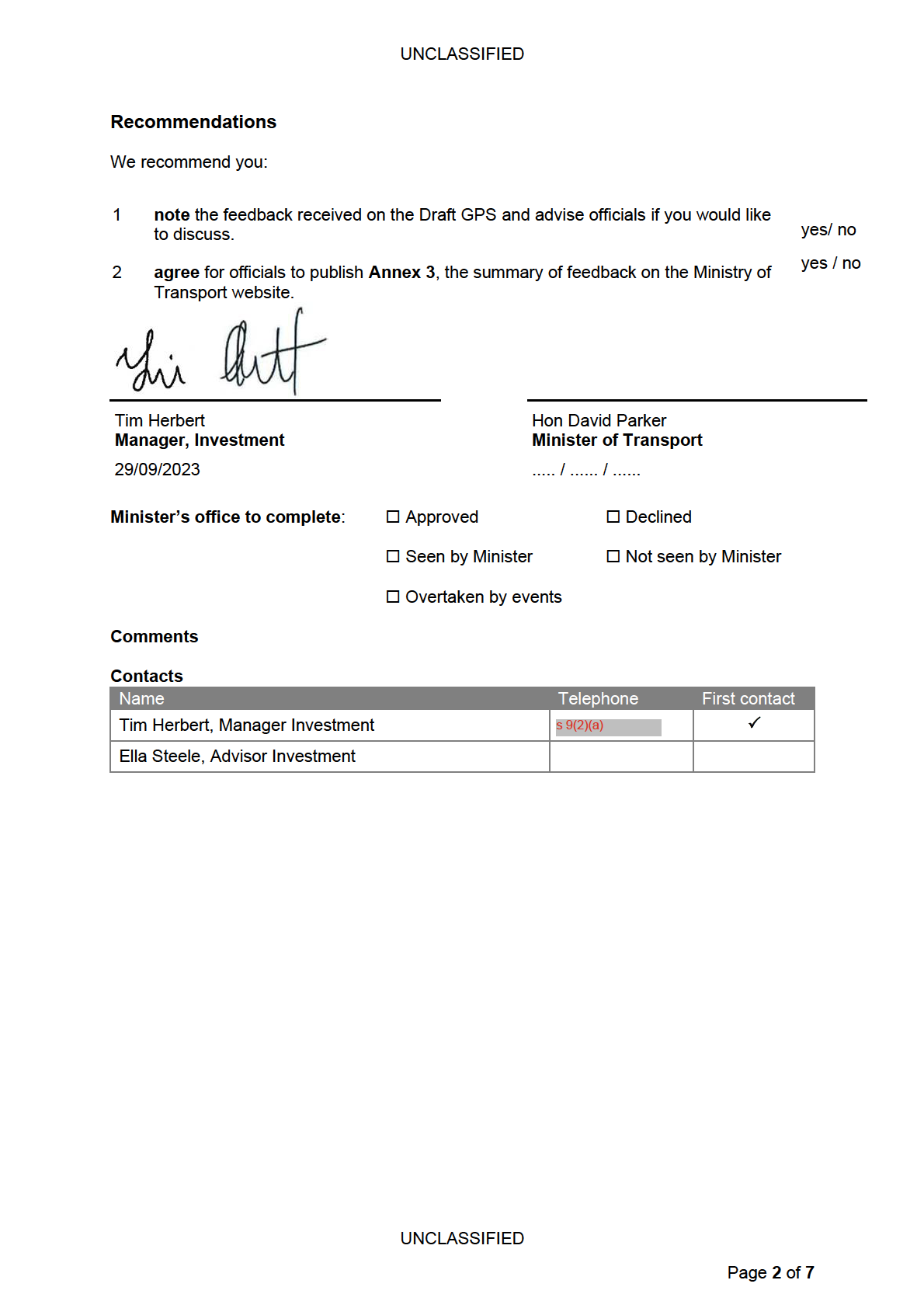
1982
THE
ACT
UNDER
INFORMATION
RELEASED
OFFICIAL
UNCLASSIFIED
DRAFT GOVERNMENT POLICY STATEMENT 2024 (GPS 2024)
SUMMARY OF FEEDBACK FROM CONSULTATION
Summary of public feedback received
1
We received 351 submissions, from a range of local government and interest groups
(
Annex 1 refers). This included 271 survey responses and 80 email submissions. A
summary of the submissions is provided below. A high-level summary suitable for
publication is included in
Annex 3.
Some key themes arising from all feedback:
Feedback on the strategic priorities
1982
2
Most submitters were generally supportive of the strategic priorities. A common
request was to rank or weight the strategic priorities as there was concern that the
THE
number of priorities would create a lack of direction. For example, the following
priorities received particular attention:
ACT
2.1 Maintaining and operating the system was of particular interest to some
individuals, councils, roading, and construction groups. Some suggesting this
should be the over-arching priority, or default area of focus.
2.2 Emissions reduction or climate change was also frequently requested to be the
UNDER
overarching priority, by some individuals, councils, climate, and other advocacy
groups.
2.3 The safety priority was an area of interest, with several submitters noting that
the GPS appears to dilute the ambition of Road to Zero, impacting the target of
death and serious injury prevention.
3
Many submitters, including individuals and local councils, noted that the ambition of
INFORMATION
the strategic priorities does not appear to align with the available funding in the
activity class funding ranges.
RELEASED
Feedback on the Strategic Investment Programme (SIP)
4
Submitters tended to support projects within their region, and the programme as a
whole received support from national road interest advocacy groups. A range of
respondents indicated disappointment that projects in their region were not included
within the SIP and indicated a desire for such projects to be included.
OFFICIAL
5
Several submitters questioned the impact these projects would have on emissions
and requested impact analysis be completed.
6
Councils and Regional Transport Committees were concerned about the lack of
funding certainty for the SIP projects past the 2024-27 period.
Feedback on proposed funding levels and allocation across activity classes
UNCLASSIFIED
Page
3 of
7
UNCLASSIFIED
7
Across the board, submitters frequently agreed with the increase in funding, but often
noted that more funding is needed. There was concern about the long-term
sustainability of the National Land Transport Fund (NLTF), and the impact of debt
repayments in out-years.
8
While submitters often agreed with the funding allocation, more frequently,
submissions requested that specific activity classes be allocated more or less
funding. Generally, groups representing motorists, commercial, and construction
groups prioritised investment in maintenance and new roading infrastructure. Some
even expressing interest in seeing other revenue sources utilised (ie road tolls or
congestion charging). In contrast, other submitters such as environmental, safety and
other advocacy groups, identified alternatives to car use as a high priority for
improving the transport system, and thought investment in public transport and active
modes of transport should increase.
9
Over 50 submissions expressed concern about the removal of the Road to Zero
1982
Activity Class. The concern related primarily to the reallocation of previously ring-
fenced funding for safety improvements into Local Road and State Highway
THE
Improvements. Submitters suggested that this would risk losing momentum on
meeting performance targets for reductions of transport-related deaths and serious
ACT
injuries (40% reduction by 2030). Concern was primarily from local councils and
safety advocacy groups.
Feedback on the Ministerial Expectations
UNDER
10
There was general support for the Ministerial Expectations section. In particular
submitters, largely local councils, signalled support for Build Back Better (BBB), and
Value for Money (VfM) principles.
11
There were some climate-based concerns in this section, including a small number of
requests to bring back the high-threshold for emissions that was signalled in the
indicative priorities released earlier this year. There were also several submitters who
noted that VfM and BBB should incorporate the full range of additional benefits (such
as health) over and above emission reduction. These comments were mostly from
INFORMATION
individuals and climate change advocacy groups.
RELEASED
12
There was some scepticism that Waka Kotaki would realistically be able to deliver the
expectations, given the costs involved and the direction and funding provided in the
draft GPS (i.e. the BBB could lead to considerable cost increases which might be
difficult to meet, or the SIP seeming to be at odds with emissions reduction priority for
example). Several individuals requested that this section should include additional
requirements for reporting, including more detailed reporting and more measurable
outputs and outcomes (such as emissions levels).
OFFICIAL
Additional general feedback
13
There was a significant volume of submissions that advocated for specific regions,
projects, policies or interventions in the transport system. This included advocacy for
rural areas and particular roads or bridges, and details of why these projects are
important.
14
Dozens of submitters suggested the GPS include expectations that additional
interventions are implemented to meet transport outcomes. These included
UNCLASSIFIED
Page
4 of
7
UNCLASSIFIED
congestion charging, car-free city centres, and biofuels. Some submitters emphasised
the need to invest in public transport and active modes of transport instead of roads,
while others remarked that the funding from Fuel Excise Duty (FED) and Road User
Charges (RUC) should only be re-invested in the roading network.
15
Several councils requested earlier release of the draft GPS (ie, this should be
finalised 12 months before the election) to allow for the National Land Transport Plan
(NLTP) to be settled eight months ahead of its planned start date (1 July 2024) and
allow more time for consideration during consultation. Delays make it difficult for
councils to fully implement the GPS in their work. Some suggested that the GPS
should have a longer-term outlook or be a cross-party document to allow for efficient
long-term planning from councils.
Engagement with Government agencies
16
Departmental consultation on the Draft GPS and Cabinet paper was not undertaken
1982
prior to seeking Cabinet agreement to release the Draft GPS due to time constraints.
The Ministry did however work closely with the Treasury and Waka Kotahi to develop
THE
the proposed funding package, comprised of FED and RUC increases, Crown funding
and financing.
ACT
17
Alongside the public consultation process, we have provided Government agencies
with the opportunity to provide feedback on the Draft GPS, including meeting with the
Urban Development and Infrastructure agencies. We received written feedback on
the Draft GPS from Housing and Urban Development (HUD), Kāinga Ora and
UNDER
KiwiRail.
17.1 HUD and Kāinga Ora proposed specific wording changes to the ‘Sustainable
urban and regional development strategic priority’ to reinforce the role that
transport investment plays in shaping urban form and increasing housing
supply, choice and affordability, including by referring to the need to coordinate
transport planning with proposed resource management reforms (eg Regional
Spatial Strategies). HUD and Kāinga Ora also proposed reporting measures to
monitor progress against these objectives.
INFORMATION
17.2 KiwiRail were supportive of the strategic priorities and the rail projects included
RELEASED
in the Strategic Investment Programme. KiwiRail are keen to work further on the
detail of these projects, particularly understanding the opportunities around level
crossings in Auckland and Wellington. Similar to Waka Kotahi, KiwiRail raised
questions about how the Inter-regional public transport activity class would
operate, highlighting a need to clarify this in the final GPS. For example,
clarifying whether it is accessible for existing, as well as new inter-regional
services. KiwiRail also emphasised the cost pressures it is facing in delivering
OFFICIAL
the RNIP in metropolitan areas, which has resulted in shortfalls in annual
maintenance and renewals. Any additional Crown funding to address these
concerns will need to be considered through the Budget 2024 process, which
we will be advising on in due course.
Waka Kotahi feedback
18
Waka Kotahi Board feedback is attached at
Annex 4.
UNCLASSIFIED
Page
5 of
7
UNCLASSIFIED
19
Key points from the submission include:
19.1 Overall support for the draft GPS 2024, noting particularly Waka Kotahi’s thanks
for the additional funding and inclusion of the Strategic Investment Programme
directly in the NLTF.
19.2 In-principle support for restructuring the existing $2 billion loan and the new
$3.1 billion loan. However, this support is subject to four conditions that may
prove difficult to meet.
19.3 Observation that the NLTF funding position is not sustainable and that, as a
consequence, Waka Kotahi will need to take a cautious approach to advancing
the Strategic Investment Programme until there is a funding pathway available
to deliver it. The submission also requests clarity about how the government will
fund delivery of VKT reduction and other climate mitigation measures, climate
adaptation works, and the Carbon Neutral Government Programme. 1982
19.4 Offer of Waka Kotahi resources to assist with the revenue review.
THE
19.5 A request that the GPS clarify the government’s road safety objectives,
particularly whether there is a Crown expectation that the NLTF should prioritise
ACT
safety initiatives over others in the improvement, maintenance, and renewals
activity classes.
19.6 A number of editorial suggestions for the final version of the document, to
provide Waka Kotahi and others with more clarity on various policy points.
UNDER
20
Treasury and Ministry officials are commencing work with Waka Kotahi to determine if
loan terms acceptable to the government can be agreed. Waka Kotahi’s suggestions
on urban development’s focus on compact urban form. This may contrast with HUD’s
suggestions focusing on affordable development, including greenfield sites as well as
higher-density development. Tensions between these perspectives remain to be
resolved before the final GPS is published.
INFORMATION
Feedback from Ko Tātou Local Government New Zealand
RELEASED
21
Ko Tātou Local Government New Zealand (LGNZ) is the peak body representing the
interests of local government. In collaboration with the Transport Special Interest
Group of LGNZ, we held three online workshops for local government officials to
discuss the details in the draft GPS 2024 with Ministry of Transport officials.
22
LGNZ submitted its support for the general direction of the draft GPS, but noted that
significantly more work is needed to deliver an integrated strategy with sustainable
OFFICIAL
levels of funding.
23
Key points from the submission include:
• Many of LGNZ’s recommendations for improvement are about progressing work
to secure sustainable funding for local government infrastructure, which is largely
being progressed under the Future of the Revenue System project or wider
Government policy work.
UNCLASSIFIED
Page
6 of
7
UNCLASSIFIED
• An emphasis on the need to increase funding towards maintenance (including in
response to cyclone damage) and resilience.
We consider this will be addressed
through the draft GPS funding settings and the expectation to ‘build back better’.
In addition, the Government has approved approximately $1.76 billion of Crown
funding (through Budget 2023 and National Resilience Plan funding rounds) for
roading response and recovery works following the North Island Weather Events.
The Ministry is continuing to work with Waka Kotahi and Treasury to identify and
address where further Crown funding may be requested to progress cyclone
recovery works.
Feedback from the Equestrian Community
24
There were 174 submissions from submitters who had a primary focus on advocating
for the inclusion of horses, riders and bridleways in the GPS.
25
These submissions were generally concerned that there was no mention of 1982
bridleways, or horses/riders (as legal road users) in the draft GPS 2024. Common
requests were to include funding for horses as an active mode of transport, and for
THE
shared use of safe offroad pathways.
ACT
26
Horse and rider safety was also frequently addressed by the equestrian community,
who citied a need for driver education and safety consideration in the draft GPS.
Several submitters considered the draft GPS 2024 does not live up to the 2022-23
letter of expectations from Minister Michael Wood which mentions building a "safe
system that… enables access for cycling, walking and equestrian communities."
UNDER
27
We expect the funding and implementation of bridleways to be handled at a local
government level.
Next Steps
28
Officials are available to discuss feedback received.
29
Officials plan to upload
Annex 3 to the GPS page on our website for the public to see
INFORMATION
their feedback summarised. This is in-line with previous practice for the draft GPS
2021.
RELEASED
30
Following the general election, we will support the Minister of Transport to finalise the
GPS, informed by the feedback received.
OFFICIAL
UNCLASSIFIED
Page
7 of
7
UNCLASSIFIED
ANNEX 1: SUBMITTERS ON THE DRAFT GPS 2024
See below a list of submitters organised by which group they represent. Numbers of
submissions for each kind of group include when submissions have been sent through by
individuals in support of a group (eg there were multiple individuals who submitted on behalf
of the equestrian community).
Individuals (79)
Various
Local
Ashburton District Council
government (52) Auckland Council
Auckland Regional Transport
Bay of Plenty Regional Council - Regional Transport Committee
Canterbury Regional Council
Canterbury Mayoral Forum & Canterbury Regional Transport
Committee
1982
Christchurch City Council
Dunedin City Council
THE
Environment Canterbury Regional Council
Environment Southland & Otago Regional Council ACT
Far North District Council
Future Proof, Waikato Regional Council
Greater Christchurch Partnership
Greater Wellington Regional Council/Metlink
Hamilton City Council
UNDER
Hawke’s Bay Regional Council
Hawke’s Bay Regional Transport Committee
Horizons Regional Council
Invercargill City Council
Kapiti Coast District Council
Local Government New Zealand
Mackenzie District Council
Manawatu District Council
INFORMATION
Marlborough District Council
Nelson Regional Development Agency
RELEASED
Northland Regional Transport Committee, Northland Regional Council
Otago Regional Council
Palmerston North City Council
Porirua City Council
Queenstown Lakes District Council
Selwyn District Council
Taituarā - Local Government Professionals Aotearoa
OFFICIAL
Taranaki Regional Council
Tasman District Council & Nelson Tasman RTC
Tauranga City Council
Thames-Coromandel District Council
Timaru District Council
TSIG officers (informal submission)
Upper Hutt City Council
Waikato District Council
Waikato Regional Transport Committee
UNCLASSIFIED
Page
1 of
3
UNCLASSIFIED
Waimakariri District Council
Wellington City Council
Wellington Regional Transport Committee
Western Bay of Plenty District Council
Equestrian
Ashburton Pony Club
community
Canterbury Harness Horse & Pony Society Inc
groups (174)
Dalefield Horse Riding Park
Equestrian sport New Zealand
Hawkes Bay Horse Trail Advocacy
Hawkes Bay Horse trails Advocacy Group
Morgan Horse Association of New Zealand (MHANZ)
New Zealand Equestrian Advocacy Network
New Zealand Riding Clubs and Bridleways of New Zealand Inc.
NZ Equestrian Advocacy Network + NZ Side Saddle Association
Pony Riding School for children.
1982
Recreational Riders Bay of Plenty
Taranaki Equestrian Network
THE
Taupo Dressage Group
Wakatipu Riding Club
ACT
Construction,
Automobile Association (AA)
road, rail
Civil Contractors New Zealand
engineering and Energy Resources Aotearoa
commercial
Engineering New Zealand
sectors (9)
Engineering New Zealand Transportation Group (TG)
UNDER
Federation of Rail Organisations of New Zealand
Ia Ara Aotearoa Transporting New Zealand Inc
Motor Trade Association (MTA)
Trafinz (NZ Traffic Institute Inc)
Other advocacy
Free Fares NZ
groups (5)
Rural Women New Zealand
Taxpayers' Union
The New Zealand Initiative
INFORMATION
Commercial and Bus & Coach Association New Zealand
business
Business NZ
RELEASED
interests (16)
CentrePort Ltd
Federated Farmers of New Zealand
Fonterra
Kernohan Engineering Ltd
Milestone Homes Nelson Bays Ltd
Mobil Oil New Zealand Ltd
Nelson Tasman Chamber of Commerce
OFFICIAL
Port Nelson
Property Council NZ
Tauranga Business Chamber
Te Waka, Waikato Regional Economic Development Ltd
The Canterbury Employers’ Chamber of Commerce
Wellington Airport
Wellington Chamber of Commerce
Environment
Lawyers for Climate Action New Zealand
groups (3)
OraTaiao: NZ Climate and Health Council
UNCLASSIFIED
Page
2 of
3
UNCLASSIFIED
Active transport
Bike Auckland
mode groups (3) Living Streets Aotearoa
Spokes Canterbury
Safety advocacy Australasian College of Road safety
groups (3)
Brake, the road safety charity
Global Road Safety Partnership (GRSP)
Central
Director of Land Transport at Waka Kotahi
government (3)
National Public Health Service
Waka Kotahi
Iwi or other
Te Hapori Hoiho National Māori Horse Association
Māori groups (3) Wakatu Incorporation
community
Ashburton Citizens Association
groups (1)
1982
THE
ACT
UNDER
INFORMATION
RELEASED
OFFICIAL
UNCLASSIFIED
Page
3 of
3
UNCLASSIFIED
ANNEX 2: SUMMARY OF SURVEY RESPONSES
Email submissions received total: 80
Online survey submissions total: 271
There was particular engagement via the survey from 166 people requesting the inclusion of
horses and bridleways in GPS 2024, who we have recorded separately in the table below.
On line survey submission stances
Survey
Members of
Total all
respondents
the
survey
(except for
equestrian
submissions
equestrian
community
community)
1982
Agree or strongly agree with the strategic
60
4
64
priorities and direction
THE
Disagree or strongly disagree with the
20
147
171
strategic priorities and direction
ACT
Agree or strongly agree with the funding
53
113
166
increases
Disagree or strongly disagree with the
21
20
40
funding increases
UNDER
Agree or strongly agree with the Ministerial 37
4
41
expectations
Disagree or strongly disagree with
12
126
138
Ministerial expectations
Responses total
105 (39% of all
166 (61% of all
271
survey
survey
INFORMATION
submissions)
submissions)
RELEASED
OFFICIAL
UNCLASSIFIED
Page
1 of
4
UNCLASSIFIED
ANNEX 3: A3 SUMMARY
Document attached in email.
1982
THE
ACT
UNDER
INFORMATION
RELEASED
OFFICIAL
UNCLASSIFIED
Page
2 of
4
UNCLASSIFIED
ANNEX 4: WAKA KOTAHI BOARD FEEDBACK
Document attached in email.
1982
THE
ACT
UNDER
INFORMATION
RELEASED
OFFICIAL
UNCLASSIFIED
Page
3 of
4
UNCLASSIFIED
ANNEX 5: KO TĀTOU LOCAL GOVERNMENT NEW ZEALAND FEEDBACK
Document attached in email.
1982
THE
ACT
UNDER
INFORMATION
RELEASED
OFFICIAL
UNCLASSIFIED
Page
4 of
4

1982
THE
ACT
UNDER
INFORMATION
RELEASED
OFFICIAL
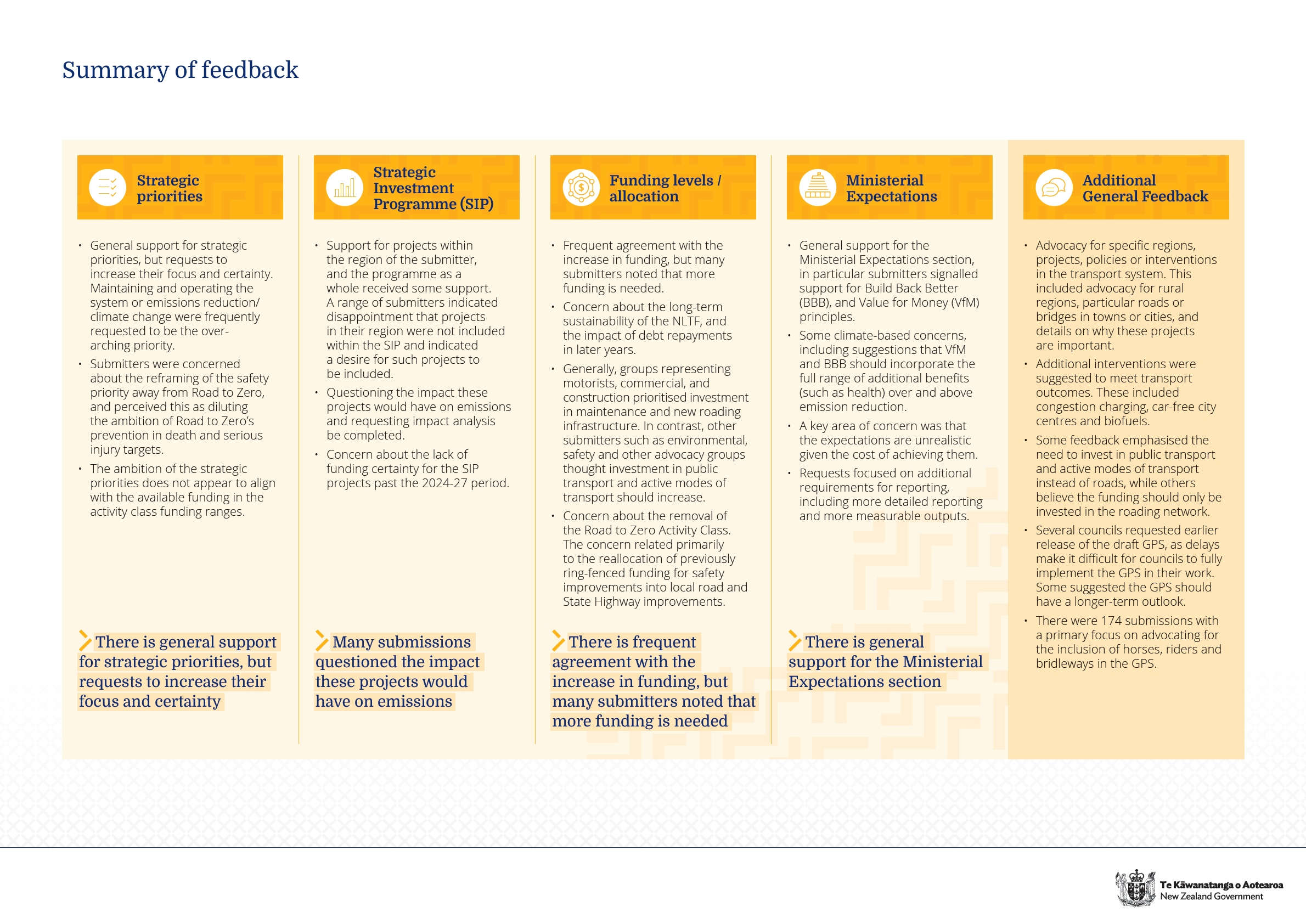
1982
THE
ACT
UNDER
INFORMATION
RELEASED
OFFICIAL
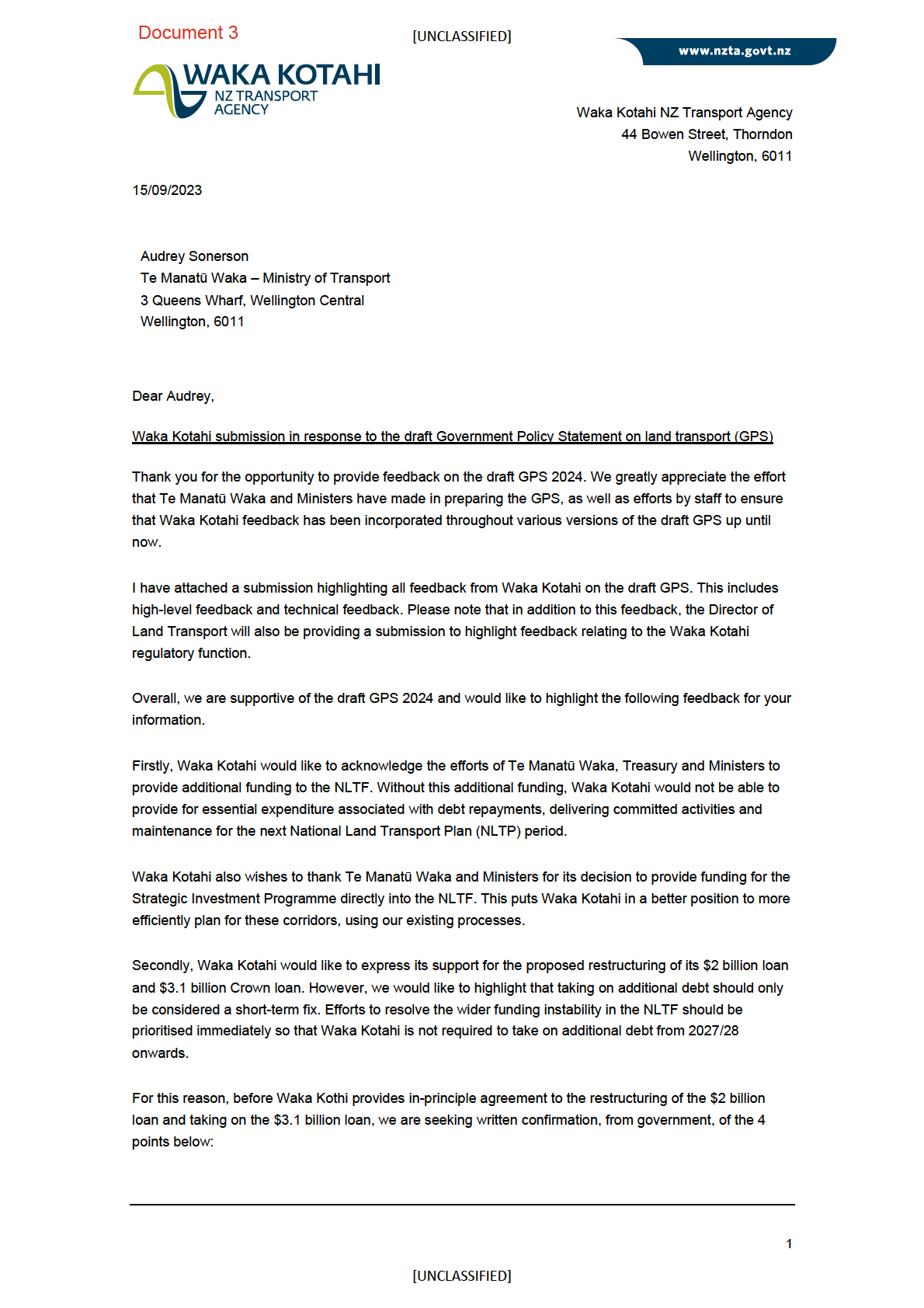
1982
THE
ACT
UNDER
INFORMATION
RELEASED
OFFICIAL
[UNCLASSIFIED]
• Address the recommendations that have been highlighted in the Land Transport Revenue
Review.
• Confirm a plan to resolve NLTF funding constraints (with support from Waka Kotahi) by 2027.
• Support and accelerate implementation of policy and operational aspects to enable
implementation of a new pricing and funding regime by 2027, e.g. new pricing model, congestion
charging, E-RUC, telematics.
• Provide assurances that the Crown wil underwrite debt liabilities of the NLTP if additional and
substitute revenue sources are not secured in this period.
Waka Kotahi is happy to provide any additional resources to support the prioritisation of the Land
Transport Revenue Review and wil assist in any way we can to support this work progressing as soon as
possible.
1982
Thirdly, Waka Kotahi recommends that government changes the name of the “Strategic Investment
THE
Programme” to “Strategic Investment Corridors” so that it is clear that this is a set of corridors that
government would like Waka Kotahi to consider in the development of the NLTP. ACT
It is also important to note that with current forecasts of the NLTP, Waka Kotahi wil not have enough
revenue to cover the cost of delivering these strategic investments once planning has been completed.
This creates risk both in terms of community expectations and around the potential for planning to occur
well before a project can be delivered, resulting in additional cost and rework. This means that Waka
Kotahi wil need to take a cautious approach in determining whether to fund the planning of these projects
UNDER
because we wil need to confirm that there is a pathway to deliver them.
Fourth, the draft GPS 2024 cal s out the need to ensure that the transport system is accessible to all New
Zealanders and specifically notes Māori, disabled people and rural and regional communities as key
groups that may experience issues with access that require additional interventions. The draft GPS also
notes that a “
focus for GPS 2024 is on ensuring Māori aspirations for the land transport system are better
reflected at the strategic level.” To ensure that Māori aspirations are reflected in the draft GPS, to the
extent it hasn’t already been done, we strongly support transport sector-wide engagement with Māori and
INFORMATION
offer our support to Te Manatū Waka with any future engagement or col aboration with Māori as it occurs.
RELEASED
Fifth, we note that the draft GPS 2024 is not clear about how climate mitigation and climate adaptation
expectations wil be funded. To provide a sense of scale, Treasury has estimated that capital expenditure
to reduce transport emissions could be upwards of $20 bil ion over 10 years from 2025.1 We note in this
context that while Government is funding development of urban light VKT reduction programmes, it has not
committed to funding delivery of them, and there is unlikely to be much headroom in the NLTF for the
‘additionality’ they provide.
OFFICIAL
Proposed funding settings also do not appear to account for the potential costs associated with
transitioning to Carbon Neutral Government Programme (CNGP)-compliant infrastructure activities by
2025. At the same time, should the proposed strategic investment programme proceed to delivery in
future, it contains projects that may increase emissions.
1 Ngā Kōrero Āhuarangi Me Te Ōhanga: Climate Economic and Fiscal Assessment 2023 p. 71.
2
[UNCLASSIFIED]

[UNCLASSIFIED]
The impact of this funding (and policy) uncertainty is that delivery of significant, additional improvements
for public transport, walking and cycling are unlikely to be funded from the NLTF during the 2024-2027
NLTP period. Availability of further Crown funding is also uncertain. This puts achievement of emissions
reductions expected from transport from 2026 (the second emissions budget period) at risk. For this
reason, we recommend that the GPS 2024 contemplate these risks and provide further clarity about how it
intends to respond to these risks.
Sixth, Waka Kotahi notes that over the last year, it has been asked by government to slow down aspects of
the Road to Zero programme and in particular, speed changes. This means that other aspects of the road
safety programme like infrastructure investment and policing wil need accelerated investment if we are to
continue to target a 40% reduction in death and serious harm by 2030.
1982
If Road to Zero activities cannot be delivered, and in some cases, significantly accelerated through this
NLTP period, we wil not meet the 40% reduction target. This would require additional investment as wel
THE
as prioritisation of this investment, over others like resilience and adaptation. To resolve this risk, we
recommend that the GPS clarify whether there is a Crown expectation that the NLTF should prioritise
ACT
safety improvement initiatives over others in the improvement, maintenance, and renewals activity classes
and whether there wil be additional funding for this purpose where required. If neither of these apply, we
suggest the government consider adjusting Road to Zero targets to reflect a slower path to delivery of
these outcomes through this GPS and NLTP period.
UNDER
Seventh, Waka Kotahi requests that the draft GPS be updated to include more information about the
importance of digitisation (e.g. supporting technological advances to support transport options), customer
enablement (providing communities with specific resources to resolve challenges) and pricing (e.g.
congestion charging) to respond to some of the funding challenges Waka Kotahi and the wider transport
system experiences. This may include further work on considering congestion pricing, or specifical y calling
out the Waka Kotahi Innovation Fund as a fund that needs to be continued.
Finally, we ask that the final version of the draft GPS goes through a final review by Waka Kotahi and
INFORMATION
Crown Law before it is finalised.
RELEASED
The Board welcomes any opportunity to discuss our feedback on the draft GPS 2024, either with Te
Manatū Waka or Ministers.
Ngā mihi
OFFICIAL
Dr Paul H.S. Reynolds QSO
Waka Kotahi Board Chair
3
[UNCLASSIFIED]

[UNCLASSIFIED]
Draft GPS 2024 Public Consultation
Waka Kotahi NZ Transport Agency Submission
15 SEPTEMBER 2023
Waka Kotahi appreciates the opportunity to provide feedback on the draft GPS 2024.
We have outlined our feedback below, covering high level feedback up front and more technical
feedback underneath this.
We are more than happy to discuss our submission with you if required.
1982
____________________________________________________________________________
THE
High-level feedback
ACT
Support for proposed top-up to the NLTF
Waka Kotahi would like to acknowledge and express their appreciation for the efforts of Te
Manatū Waka and Ministers to provide additional funding to the NLTF. Without this additional
funding, Waka Kotahi would not be able to provide for essential expenditure associated with
debt repayments, delivering committed activities and maintenance for the next NLTP period.
UNDER
Waka Kotahi also wishes to thank Te Manatū Waka and Ministers for its decision to provide
additional funding for the Strategic Investment Programme as a top-up to the NLTF, rather than
keeping this funding separate (like what was done with the NZ Upgrade Programme). This
enables Waka Kotahi to be in a better position to plan for the Strategic Investment Programme
more efficiently, as we can use our existing processes.
In-principle agreement to restructuring of debt, provided conditions are met in writing
INFORMATION
Waka Kotahi would like to highlight that taking on any additional debt should only be considered
a short-term fix. Efforts to resolve the wider funding instability in the NLTF should be prioritised
RELEASED
immediately so that Waka Kotahi is not required to take on additional debt from 2027/28
onwards.
If the current system remains, the next NLTP will require Waka Kotahi to either take on more
debt in the next NLTP period or see a substantial increase to revenue through existing
mechanisms i.e. FED/RUC or other charging mechanisms. This way of doing things is not
sustainable and changes to our revenue system are desperately needed before the 2027 – 2030
OFFICIAL
period.
For this reason, before Waka Kothi provides in-principle agreement to the restructuring of the $2
billion loan and taking on the $3.1 billion loan, we are seeking written confirmation, from
government, of the 4 points below:
• Address the recommendations that have been highlighted in the Land Transport
Revenue Review.
• Confirm a plan to resolve NLTF funding constraints (with support from Waka Kotahi) by
2027.
[UNCLASSIFIED]
[UNCLASSIFIED]
• Support and accelerate implementation of policy and operational aspects to enable
implementation of a new pricing and funding regime by 2027, e.g. new pricing model,
congestion charging, E-RUC, telematics.
• Provide assurances that the Crown will underwrite debt liabilities of the NLTP if additional
and substitute revenue sources are not secured in this period.
Waka Kotahi is happy to provide any additional resources to support the prioritisation of the
Land Transport Revenue Review and will assist in any way we can to support this work
progressing as soon as possible.
Providing greater clarity about the strategic priorities
Waka Kotahi supports the strategic priorities that have been included in the draft GPS and notes
that these are expected to be advanced through investment from a variety of different sources,
not just through NLTF. It would be helpful if it was made clear in the Strategic Priorities section
of the draft that Waka Kotahi is expected to take an integrated investment approach across
1982
funding sources to ensure the NLTF can be leveraged to deliver the greatest benefits across
multiple priorities and outcomes, while also recognising that the priority for NLTF funding is to
THE
ensure the ongoing operation and maintenance of the system. These expectations feature
across other parts of the draft GPS, but it would be helpful to have them made clearer in the
ACT
Strategic Priorities section to avoid confusion.
Strategic Investment Programme
Waka Kotahi recommends that government changes the name of the “Strategic Investment
UNDER
Programme to “Strategic Investment Corridors” so that it is clear that this is a set of corridors that
government would like Waka Kotahi to consider in the development of the NLTP.
It is also important to note that with current forecasts of the NLTP, Waka Kotahi will not have
enough revenue to cover the cost of delivering these strategic investments once planning has
been completed. This creates risk both in terms of community expectations and around the
potential for planning to occur well before a project can be delivered, resulting in additional cost
and rework.
INFORMATION
This means that Waka Kotahi will need to consider the wider impacts of funding these projects,
such as how this impacts the ability of other committed activities to be funded, plus any surprise
RELEASED
changes to funding arrangements that could be introduced (i.e. an expectation on the NLTP to
cover NZ Upgrade Programme costs). Waka Kotahi will also need to carefully manage
stakeholder expectations throughout this process.
We recommend that the draft GPS 2024 include a commitment to fund Strategic Investment
Corridors that are progressed beyond 2027, provided projects aligns with government strategic
priorities and are efficient and effective. In the absence of this commitment, Waka Kotahi will
OFFICIAL
take a very cautious approach in approving the funding for these projects to ensure that there is
a pathway to delivery.
Ensuring engagement with Māori
The draft GPS 2024 calls out the need to ensure that the transport system is accessible to all
New Zealanders and specifically notes Māori, disabled people and rural and regional
communities as key groups that may experience issues with access, that may require additional
interventions.
Draft GPS 2024 Public Consultation
Waka Kotahi NZ Transport Agency
- 2
[UNCLASSIFIED]
[UNCLASSIFIED]
The draft GPS 2024 also notes that a “
focus for GPS 2024 is on ensuring Māori aspirations for
the land transport system are better reflected at the strategic level.” To ensure that Māori
aspirations are reflected in the draft GPS, to the extent it hasn’t already been done, we strongly
support transport sector-wide engagement with Māori and offer our support to Te Manatū Waka
with any future engagement or collaboration with Māori as it occurs.
Expectations for climate investment need to be clarified
The Emissions Reduction Plan (ERP), the Climate Emergency Response Fund (CERF) the
Carbon Neutral Government Programme (CNGP) and the National Adaptation Plan (NAP)
assign activities for Waka Kotahi to lead or co-lead. Many of these are funded or managed via
existing delivery programmes.
In addition to these actions, the ERP and NAP contain expectations of increased pace and scale
of funding for climate mitigation (e.g., delivery of significant infrastructure and service
improvements for public transport, walking and cycling; demand management and network
1982
optimisation); and climate adaptation (planning and delivery of long-term climate resilience and
adaptation as opposed to emergency response and recovery).
THE
However, the draft GPS 2024 is not clear about how these climate mitigation and climate
adaptation expectations will be funded.
ACT
To provide a sense of scale, Treasury has estimated that capital expenditure to reduce transport
emissions could be upwards of $20 billion over 10 years from 2025.1 We note in this context that
while Government is funding development of urban light VKT reduction programmes, it has not
as yet committed to funding delivery of them, and there is unlikely to be much headroom in the
UNDER
NLTF for the ‘additionality’ they provide.
Proposed funding settings also do not appear to account for the potential costs associated with
transitioning to CNGP-compliant infrastructure activities by 2025. At the same time, should the
proposed strategic investment programme projects proceed to delivery in future, it contains
projects that may increase emissions.
The impact of this funding (and policy) uncertainty is that delivery of significant, additional
improvements for public transport, walking and cycling are unlikely to be funded from the NLTF
INFORMATION
during the 2024-2027 NLTP period. Availability of further Crown funding is also uncertain. This
puts achievement of emissions reductions expected from transport from 2026 (the second
RELEASED
emissions budget period) at risk. It also diminishes the potential for significant equity, health,
congestion and affordability benefits through place-shaping land use and mode-shift
interventions.
We recommend that the GPS 2024 contemplate these risks and provide further clarity about
how it intends to respond to these risks.
OFFICIAL
Expectations for Road to Zero need to be clarified
Waka Kotahi has committed to delivering a 40% reduction in deaths and serious injuries by 2030
(from 2018 levels) as part of the Road to Zero Programme.
1 Ngā Kōrero Āhuarangi Me Te Ōhanga: Climate Economic and Fiscal Assessment 2023 p. 71.
Draft GPS 2024 Public Consultation
Waka Kotahi NZ Transport Agency
- 3
[UNCLASSIFIED]
[UNCLASSIFIED]
Over the last year, Waka Kotahi have been asked by government to slow down aspects of the
Road to Zero programme and in particular, speed changes. This means that other aspects of the
road safety programme like infrastructure investment and policing will need accelerated
investment if we are to continue to target a 40% reduction in death and serious harm by 2030.
If Road to Zero activities cannot be delivered, and in some cases, significantly accelerated
through this NLTP period, we will not meet the 40% reduction target. This would require
additional investment as well as prioritisation of this investment, over others like resilience and
adaptation.
To resolve this risk, we suggest that the GPS clarify whether there is a Crown expectation that
the NLTF should prioritise safety improvement initiatives over others in the improvement,
maintenance and renewals activity classes and whether there will be additional funding for this
purpose where required.
If neither of these apply, we suggest the government consider adjusting Road to Zero targets to
reflect a slower path to delivery of these outcomes through this GPS and NLTP period.
1982
Highlighting digitisation, customer enablement and pricing in the draft GPS
THE
Waka Kotahi requests that the draft GPS be updated to include more information about the
ACT
importance of digitisation (e.g. supporting technological advances to support transport options),
customer enablement (providing communities with specific resources to resolve challenges) and
pricing (e.g. congestion charging) to respond to some of the funding challenges Waka Kotahi
and the wider transport system experiences. This may include further work on considering
congestion pricing, using the NLTF to fund work to develop a proof of concept for alternative
UNDER
technology for road charging (e.g. universal e-RUC), or specifically calling out the Waka Kotahi
Innovation Fund as a fund that needs to be continued.
We also see an expansion on the Investment Management activity class definition to include
these elements (or the certation of a new activity class to support these interventions) as crucial,
so that these things can (or can continue to) be funded.
Ensuring that there is a final Waka Kotahi and Crown Law review of the draft GPS 2024
INFORMATION
Waka Kotahi asks that the final version of the draft GPS go through a final review by Waka
Kotahi and Crown Law before it is approved by Cabinet. This will ensure there are no remaining
RELEASED
ambiguities before it is finalised and published.
Technical feedback
____________________________________________________________________________
Roles and responsibilities
OFFICIAL
We think it would be helpful to highlight the role of the Ministry of Housing and Urban
Development and Kāinga Ora in integrated planning to ensure their land use decisions
contribute to achieving outcomes signalled in the GPS (in alignment with the GPS-HUD).
We also note that it would be helpful to highlight KiwiRail’s impact on placemaking, both through
the transport solutions it provides and how its network (or changes to its network) impacts local
communities. For example, level crossing removals (as proposed in the Strategic Investment
Programme) can have significant impacts on the community if it cuts off access from one side of
Draft GPS 2024 Public Consultation
Waka Kotahi NZ Transport Agency
- 4
[UNCLASSIFIED]
[UNCLASSIFIED]
the train tracks to the other. It is important that all organisations working on projects like this are
required to consider community impacts.
____________________________________________________________________________
Strategic Priorities
Strategic priorities should include consideration of Tū ake, Tū māia – our regulatory strategy,
which sets out how Waka Kotahi and our partners regulate the land transport system to keep it
safe for New Zealanders. The regulatory strategy informs maintenance, safety, and resilience
work programmes so it would be helpful to include this information in relevant strategic priorities.
Maintaining and Operating the System
We think there is room to broaden what is outlined in the ‘maintaining and operating the system’
strategic priority. We recommend including the following:
1982
• optimising and maintaining safety through maintenance. For example, skid resistance,
and signage could help prevent safety issues arising from poor quality assets.
THE
• reference to (and funding provision for) the mandatory requirement for Waka Kotahi to
transition its infrastructure activities to 'low emission' through Carbon Neutral
ACT
Government Programme requirements.
• reference to providing nature-based solutions more clearly (for Waka Kotahi and local
government) and make sure funding ranges reflect this.
• Highlighting the varying levels of service around the network as well as highlighting the
importance of maintaining the existing asset (and the risks of not doing so).
UNDER
• Further clarification about what ‘meeting future needs’ means in practice.
Increasing Resilience
Waka Kotahi again wishes to highlight the importance of differentiating between ‘resilience’ and
'resilience to climate change.’
This is because there are some key differences between ‘resilience’ and ‘resilience related to
climate change.’ For example, ‘resilience’ can include responses to non-climate related hazards
INFORMATION
such as earthquakes and damage caused by crashes. Responding to non-climate resilience
activities is also BAU for Waka Kotahi. ‘Resilience to climate change’ on the other hand only
RELEASED
focuses on responding to climate-related events and is interchangeable with adaptation, where
our responses and approaches are expected to change over time.
Measures of climate change adaptation and resilience are also distinct from each other and
require different mechanisms to track them.
To resolve this confusion and inconsistency, Waka Kotahi recommends changing the title of
OFFICIAL
‘increasing resilience’ to ‘Increasing Resilience and Climate adaptation’ and making the
language in the strategic priority reflect this change. This will help our partners have a clear
understanding that ‘increasing resilience’ applies to both traditional/network resilience and
climate resilience.
Reducing Emissions
We suggest that this priority be updated to reflect:
Draft GPS 2024 Public Consultation
Waka Kotahi NZ Transport Agency
- 5
[UNCLASSIFIED]

[UNCLASSIFIED]
• government requirements related to the ERP (reducing enabled emissions via urban
form and providing better transport options),
• Waka Kotahi responsibilities under the Carbon Neutral Government Programme, to
become carbon neutral by 2025, and the highly challenging nature of these
responsibilities.
• Reference to the impact of embodied emissions, which is expected to increase through
the delivery of projects, like those included in the Strategic Investment Programme.
• Highlight the need for longer-term climate resilience and adaptation planning.
• Reference the emissions budget period 2 (2026 – 2030).
Safety
We suggest the following additions be made to the safety strategic priority:
• reference the safety, health and emissions benefits that arise from reduced car travel and
increased uptake of public transport and safe walking and cycling networks. 1982
• Reference the improvements to safety that can be made through placemaking, or
THE
through piloting street changes.
Waka Kotahi also found that the draft GPS says, “it is expected that the overall level of funding
ACT
going towards safety projects wil remain constant” in a footnote on page 72. We ask that this
statement is included in the safety strategic priority description.
We also suggest the following edits in red on page 25 - “how we wil deliver these outcomes:”
UNDER
INFORMATION
RELEASED
Sustainable Urban and Regional Development
We suggest making some updates to this strategic priority, including:
• Referencing the Waka Kotahi Board position on urban development: “
Waka Kotahi
supports, enables and encourages quality, mixed-use, compact urban development that
efficiently uses land, reduces travel distances and lowers reliance on private vehicles”. We think that including this position in the GPS will help Waka Kotahi planners to
OFFICIAL
influence spatial and regional plans to get positive outcomes.
• A greater narrative about urban form – currently the strategic priority focuses heavily on
the need for more housing rather than urban form. Messaging in this section of the GPS
should instead highlight that we need more sustainable and compact urban areas that
provide affordable housing and transport. Transport has a massive role to play in
improving urban form and this should be highlighted.
Draft GPS 2024 Public Consultation
Waka Kotahi NZ Transport Agency
- 6
[UNCLASSIFIED]
[UNCLASSIFIED]
• Reducing reference to ‘low congestion,’ and instead focusing on the reliable and efficient
movement of people and freight. Overall, effective management of the system for people
and freight will help manage congestion more effectively.
• Acknowledging that there are likely to be some different understandings about what
sustainable development means between urban areas and the regions. For example,
improvements for active modes in urban areas are generally treated as a response to
people walking and cycling – either commuting or using the mode for fun. By
comparison, smaller regions will often consider active modes within the context of their
tourism industry (i.e. bike trials that visitors use recreationally). These types of nuances
should be highlighted.
• Note that further work is needed to understand what good development looks like in the
regions.
1982
Integrated Freight System
The strategic priority for integrated freight system’s reference to coastal shipping (see last bullet
THE
point on page 28) is inconsistent with the activity class definition, and references investing in
research which appears to be a reference to GPS2021 and is no longer applicable.
ACT
We ask that this reference to research be removed, and that reference to coastal shipping
include both services and infrastructure.
____________________________________________________________________________
UNDER
The Strategic Investment Programme + Corridor Studies
We ask that the “corridor studies” be included in the GPS so that funding commitments to
carrying out these studies are confirmed.
____________________________________________________________________________
Government Commitments
INFORMATION
The draft GPS should include decarbonisation of the bus fleet in its list of government
commitments RELEASED
The draft GPS 2024 does not mention the government commitment to decarbonise the bus fleet,
and we think it needs to be included as a government commitment.
With the Sustainable Public Transport Framework (realised through amendments to the LTMA)
now approved, there is a very big expectation by public transport authorities and Waka Kotahi
that the changes needed to decarbonise the bus fleet will be facilitated through the GPS and in
turn, RLTP and NLTP planning processes.
OFFICIAL
A key enabler to a decarbonised bus fleet is through strategic asset ownership (e.g. depots and
charging infrastructure). Currently no adequate allowance has been made in cost projections for
the funding needed to do this. By not making ‘decarbonising the bus fleet’ a commitment in the
GPS, and arranging funding/financing arrangements, the barrier will be too high for the
government to achieve the complete decarbonisation of the public transport bus fleet by 2035.
____________________________________________________________________________
Draft GPS 2024 Public Consultation
Waka Kotahi NZ Transport Agency
- 7
[UNCLASSIFIED]
[UNCLASSIFIED]
Meeting the land transport needs of different users
Māori
Waka Kotahi strongly supports the inclusion of an expectation to
“actively protect tino
rangatiratanga and enable Māori to exercise kaitiakitanga with respect to natural, physical and
spiritual resources.”
We note that the GPS will focus on ensuring Māori aspirations for the transport system are
better reflected at the strategic level. We suggest you utilise some of the research that has been
commissioned by Waka Kotahi to support this work. For example, Waka Kotahi Research
Report 688: A pathway towards understanding Māori aspirations for land transport in Aotearoa
NZ, provides a helpful overview of some the key challenges Māori experience in the transport
system.
Work is also underway to develop a second work - Māori experiences and expectations of our
transport system – which will likely be published around March/April 2024.
1982
THE
Supporting rural and regional communities
We recommend referencing community transport and on-demand services in this section to
ACT
support resilience and access in these areas.
_____________________________________________________________________________________
The GPS Monitoring Framework
UNDER
We note that more work is planned to refine the monitoring framework and measures in GPS
2024, and we look forward to working with Te Manatū Waka on this. We support the overall
framework structure; however the final GPS needs to be clear and explicit on:
• defining the time horizon that it is reasonable for changes to be observed in GPS
outcomes, e.g. the GPS outcomes are complex and long-term and will likely require
investment over multiple GPS periods before significant change is seen. The time
horizon for observable change set by the GPS should reflect local and international
INFORMATION
evidence about when change can reasonably be observed for different outcomes (for
example, there is already significant evidence about the time and mix of investments it
RELEASED
takes to reduce deaths and serious injuries, which the GPS should reflect).
• articulating the ability of the GPS direction and investment levels to impact the measures
selected. For example, what proportion of the vehicle fleet is low or no carbon, what
contribution do we expect GPS 2024 investment to make to this area? While the direct
Crown investment in things like the clean car standard and EV charging infrastructure is
noted, this is not within GPS activity classes and would not fall under the reporting
OFFICIAL
obligations for Waka Kotahi in section 110 of the LTMA.
• that measures of climate change adaptation and resilience are distinct from each other
(current placement in the monitoring framework appears to conflate them) and we need
to clarify what we mean by ‘adaptive capacity.’
• clearly stating that the monitoring framework and measures are not the mechanism for
assessing individual investment proposals.
Draft GPS 2024 Public Consultation
Waka Kotahi NZ Transport Agency
- 8
[UNCLASSIFIED]
[UNCLASSIFIED]
As a broader monitoring and evaluation regime for GPS delivery (as referenced in the ministerial
expectations section of the draft GPS) forms up, Waka Kotahi must be involved in its design to
ensure a manageable and meaningful monitoring approach.
____________________________________________________________________________
Activity Class Definitions
Rail Network
The proposed Rail Network activity class definition needs to reference operations, as outlined in
red below:
“Investment in a reliable and resilient national rail network, including enabling KiwiRail to deliver
ongoing operation, maintenance, renewals and improvements to the rail network.”
We also suggest that the definition be broadened to include regulatory rail functions. Doing so
1982
would enable Waka Kotahi to be funded for its input into rail infrastructure safety during
planning, design, operations, maintenance, and investment decision-making.
THE
Coastal Shipping
ACT
The activity class definition of coastal shipping does not include resilience as an outcome, which
is one of the strongest contributions coastal shipping can make to wider government objectives.
We recommend you include resilience in this definition.
UNDER
Inter-regional public transport
The intent of the Inter-Regional Public Transport activity class is not clear. A clear definition is
required as there is currently some contradiction as to whether existing services are included.
For example, is this activity for capital expenditure only, operational expenditure only (i.e. the
operation of the services, irrespective of the service being new, improved, or existing), or a
mixture of Capex and Opex?
If the intent is to include operational expenditure, it will not make sense having inter-regional
INFORMATION
services split between the Public Transport Services and Inter-Regional Public Transport activity
classes. They should only be in one activity class, and if that activity class is the Inter-Regional
RELEASED
Public Transport activity class, then the proposed funding ranges will have to cover the full 10-
year period, not the three years (2024-27) currently proposed.
If the intent is to separate inter-regional public transport services from other services funded via
the Public Transport Services activity class, there will be questions and a push from public
transport Authorities that the reason to do this is to influence the funding assistance rate for
inter-regional services, otherwise why separate them if standard FARs apply. This means further
OFFICIAL
clarification is needed from MoT (in collaboration with Waka Kotahi) that covers FARs. There is
finite revenue available for transport investment, any change to the FAR for inter-regional public
transport will mean there is less revenue available for other NLTP activities and services.
Policy should also consider the impact on existing privatised inter-regional bus and ferry
transport, which is already operational and has nationwide coverage. The definition needs to be
specific about whether it includes existing services, new services (and their business cases),
and infrastructure (rolling stock, stations, rail infrastructure) that relates to the inter-regional
services.
Draft GPS 2024 Public Consultation
Waka Kotahi NZ Transport Agency
- 9
[UNCLASSIFIED]


[UNCLASSIFIED]
It would also be helpful to understand when we can expect to see the government’s response to
the select committee inquiry into the future of inter-regional PT.
State Highway Maintenance and Local Road Maintenance
State highway maintenance and local road maintenance activity classes need to be clear they
can fund improvements as part of the ministerial direction to “build back better.” There could be
clearer instruction that a certain amount of level of service improvements can now be funded
through the state highway maintenance and local road maintenance activity classes, to support
the government’s value for money and build back better outcomes. This would be similar to the
instruction that safety infrastructure and speed management activities will now be funded from
the state highway improvements and local roads improvements activity classes.
State Highway Improvements and Local Road Improvements
State Highway Improvements and Local Road Improvements do not include automated
enforcement in their definition, we suggest this is added in.
1982
Given that the speed and infrastructure programme is being moved to the SH and local roads
THE
improvements activity classes, we suggest the definition of these should mention them. To
further support safety interventions through these activity classes, it would be helpful to include
ACT
additional language in the activity class definition to support safety. For example, wording could
be utilised from GPS 2018 as noted below:
UNDER
INFORMATION
RELEASED
GPS 2024 proposes that “infringement fees wil be hypothecated to the NLTF where it wil be
directed to support safety investments through the Road to Zero programme”. One of the most
important ways to address community (mis) perceptions around safety camera revenue is to
OFFICIAL
ensure it is directed back into critical community safety programmes and road infrastructure
safety improvements together with clear transparency and traceability. Noting the above intent to
shift safety infrastructure investment into SH and LR improvements, and the associated issues, it
will be critically important that clear and robust investment policies and pathways are established
to ensure infrastructure improvements have clear alignment with Safe System outcomes and
alignment with Road to Zero outcomes.
Walking and Cycling Improvements
Draft GPS 2024 Public Consultation
Waka Kotahi NZ Transport Agency
- 10
[UNCLASSIFIED]
[UNCLASSIFIED]
We suggest updating the definition of this activity class to include reference to improving access
to these modes for disabled people, as universal design is becoming more and more significant
in the work carried out by the walking and cycling improvements activities class.
In the Safety activity class, behavioural changes to improve road safety outcomes are
specifically mentioned, however behavioural (non-infrastructure) activities are not specifically
mentioned in the walking and cycling activity class. It is assumed these activities fall under
demand management and are therefore allowed to be funded in the W&C activity class;
however, stating this would make it clearer.
____________________________________________________________________________
Activity Class Ranges
Safety
Inputs provided to MoT during GPS development were based on a range of $1530 million (lower
1982
range) to $1850 million (upper range estimate). But the upper range in the draft GPS 2024 is
$1830 million. We ask that this this upper range be increased to $1850 million to align with
THE
forecasts.
We also ask that Safety be included in continuous programmes rather than improvements in
ACT
table 6 noting that the safety class will be focused on retaining current policing levels, continuing
road safety advertising and supporting safety camera, all existing and ongoing commitments.
Inter-regional public transport
UNDER
Projects that would fit under the Inter-Regional Public Transport umbrella are likely to be big
projects requiring lots of resources beyond 2027. Because there is no funding allocated beyond
2027, this will make it difficult for public transport authorities to want to apply for funding from this
activity class. To overcome this, we suggest including funding in the upper and lower ranges
from 2027 – 2034 to give PTAs confidence that their projects can realistically be funded under
this activity class. It will also be challenging for PTAs to try to develop new services (or even to
continue with existing services) with only three years of funding shown. We recommend a signal
in the GPS that the activity class will continue across the 10 years
INFORMATION
We recommend the minimum range is lowered (perhaps to $10m per annum) as it will be
RELEASED
challenging to meet the minimum with the known activities and allowing $10m for business
cases
Rail Network
We recommend that the Rail Network activity class ranges be widened to provide more flexibility
in times of uncertainty. This will help the activity class to account for slower than planned
delivery, or the addition of new activities, such as an increase in emergency works. We
OFFICIAL
recommend an increase of $200 million (each way) in total over 3 years to account for this.
Investment Management
Internal conversations have signalled that further funding through the Investment Management
activity class is required to cover additional funding for the long -term planning required to
support our climate responsibilities (e.g. responsibilities under the Carbon Neutral Government
Programme). While it is currently unclear how much funding is required, we would like to signal
Draft GPS 2024 Public Consultation
Waka Kotahi NZ Transport Agency
- 11
[UNCLASSIFIED]
[UNCLASSIFIED]
that we would support working with you further to increase the amounts provided in this activity
class.
Local Road Maintenance
Waka Kotahi notes that councils are likely to highlight (in their submissions) that GPS ranges for
Local Road and State Highway Maintenance Activity Classes do not make provision for the
additional Crown-funding expected for recovery works relating to Cyclone Gabrielle and the
weather events over Auckland Anniversary weekend. Early, high-level estimates suggest these
events could generate an additional funding demand of between $1Bn to $1.5Bn (NLTF) for the
Local Roads and State Highway Maintenance ($2-$3Bn combined).
In addition, initial maintenance bids received from Councils in early September indicate (un-
tensioned) funding demand of $3.7Bn excluding any provision for emergency works ($300-
$500M) and nationally delivered such as Te Ringa Maimoa and Asset Management Data
Standard (expected cost of $100M -$150M).
1982
To ensure the Board has discretion to respond to evidence and support increase investment in
council maintenance programmes, consideration should be given to increasing the upper range
THE
by ~$500M, to $4BN, - which is $600M less than the top of the range for State Highway
Maintenance.
ACT
____________________________________________________________________________
Crown Funding
We recommend referencing section 9 of the LTMA in the draft GPS. Not doing so impacts the
UNDER
ability of our regulatory function to access funding to support Search and Rescue, Met Service
and the MoT Crown Monitoring Function. Doing this would also take a wider funding approach to
the GPS as section 9 powers enable the regulation of FED/RUC (in other words, getting non-
compliant users to pay their fees), which supports the overall revenue.
____________________________________________________________________________
Ministerial Expectations
INFORMATION
Building Back Better
RELEASED
While we support the principles of ‘building back better’ in achieving multiple strategic outcomes
and value for money, the term could be better defined in the draft GPS 24-27. Traditionally,
‘build back better’ refers to the need to rebuild infrastructure in the aftermath of natural disasters
in a way that that is more resilient to future disasters.
In addition, a key chal enge to defining ‘build back better’ is understanding and agreeing to what
‘better’ means in practice. More direction is needed around what is deemed to be a sufficient
OFFICIAL
standard that meets the needs of current and future users, to enable the sector to move away
from a ‘like- for- like maintenance regime’.
There are also a number of barriers to build back better that can make processes slower and
more expensive, for example:
• there is a higher level of consultation requirement for any infrastructure delivery that is
more than just ‘like- for- like’
Draft GPS 2024 Public Consultation
Waka Kotahi NZ Transport Agency
- 12
[UNCLASSIFIED]
[UNCLASSIFIED]
• general lack of capacity and capability in the sector in identifying improvement
opportunities to deliver as part of maintenance and renewals programmes.
To resolve these issues, we suggest preparing a Waka Kotahi interpretation of ‘build back better’
that is published at the same time as the draft GPS. We would work with Te Manatū Waka and
Ministers to ensure our interpretation is aligned with GPS expectations and objectives.
To enable a multi-modal and accessible transport network, we recommend that this section
includes the direction to also consider the need for walking and cycling, which are
complementary to support public transport access and often easier and more affordable to
deliver, compared to public transport.
Supporting and building capability for innovation
One of the ways Waka Kotahi contributes to supporting and building capability for innovation is
through the Hoe ki angitū – Innovation Fund, which is administered by Waka Kotahi. 1982
A lack of reference to investment in technology, data, piloting, removing barriers to, and
investment in, innovation generally, coupled with a specific reference to innovation in relation to
THE
maintenance and renewals risks any funding for innovation going only to maintenance and
renewals.
ACT
We suggest that the draft GPS make specific reference to innovation and confirm the continued
funding of the Innovation fund.
____________________________________________________________________________
UNDER
Other Corrections
Sustainable urban and regional development – decarbonisation (page 27)
The last bul et point on page 27 notes: “Waka Kotahi and Public Transport Authorities wil adopt
the Sustainable Public Transport Framework (SPTF) and commit to decarbonising public
transport by 2035.”
Please note that the SPTF has already been adopted via the Land Transport Management
INFORMATION
(Regulation of Public Transport) Amendment Bill, and that we have only committed to
decarbonising the bus fleet, not all public transport by 2035.
RELEASED
Crown funding for land transport - Table 7: total land transport investment (page 49)
We understand that this table is to show the total land investment, however, could the header for
column 1 be changed to “Activity” rather than “Activity Class”?
As discussed, the funding shown in the Rail network row will be carried out across the Rail, PTI,
SHI, and LRI Activity Classes not just the Rail AC. In particular, a lot of the $3,335m of crown
OFFICIAL
funded activities will not come through any of the Activities Classes as it goes directly to
KiwiRail.
Table 7 appears to omit the Crown funding for Ngauranga to Petone (walking and cycling
improvements). Can this table please be updated to reflect this?
Appendix 4: Crown direct funding commitments to land transport (page 67)
Draft GPS 2024 Public Consultation
Waka Kotahi NZ Transport Agency
- 13
[UNCLASSIFIED]
[UNCLASSIFIED]
Please change the title “Crown direct funding” to “Crown funding” as some of the items on this
list are funded through the NLTF.
Glossary – Public Transport (page 69)
Under the definition of ‘public transport’ it mentions inter-regional transport by means of a rail
vehicle only. This needs to include more modes like buses and ferries, or generally public
transport.
1982
THE
ACT
UNDER
INFORMATION
RELEASED
OFFICIAL
Draft GPS 2024 Public Consultation
Waka Kotahi NZ Transport Agency
- 14
[UNCLASSIFIED]
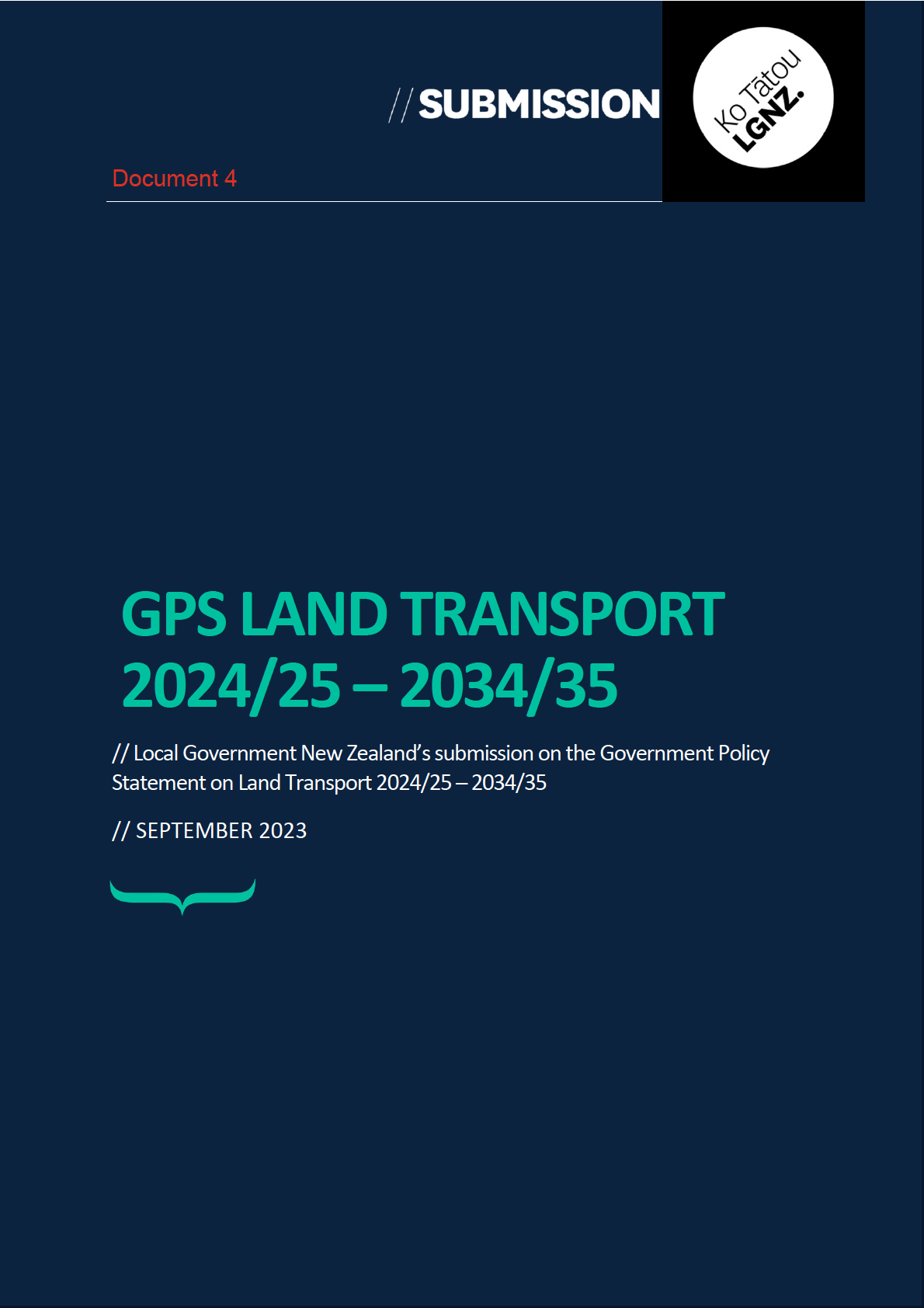
1982
THE
ACT
UNDER
INFORMATION
RELEASED
OFFICIAL
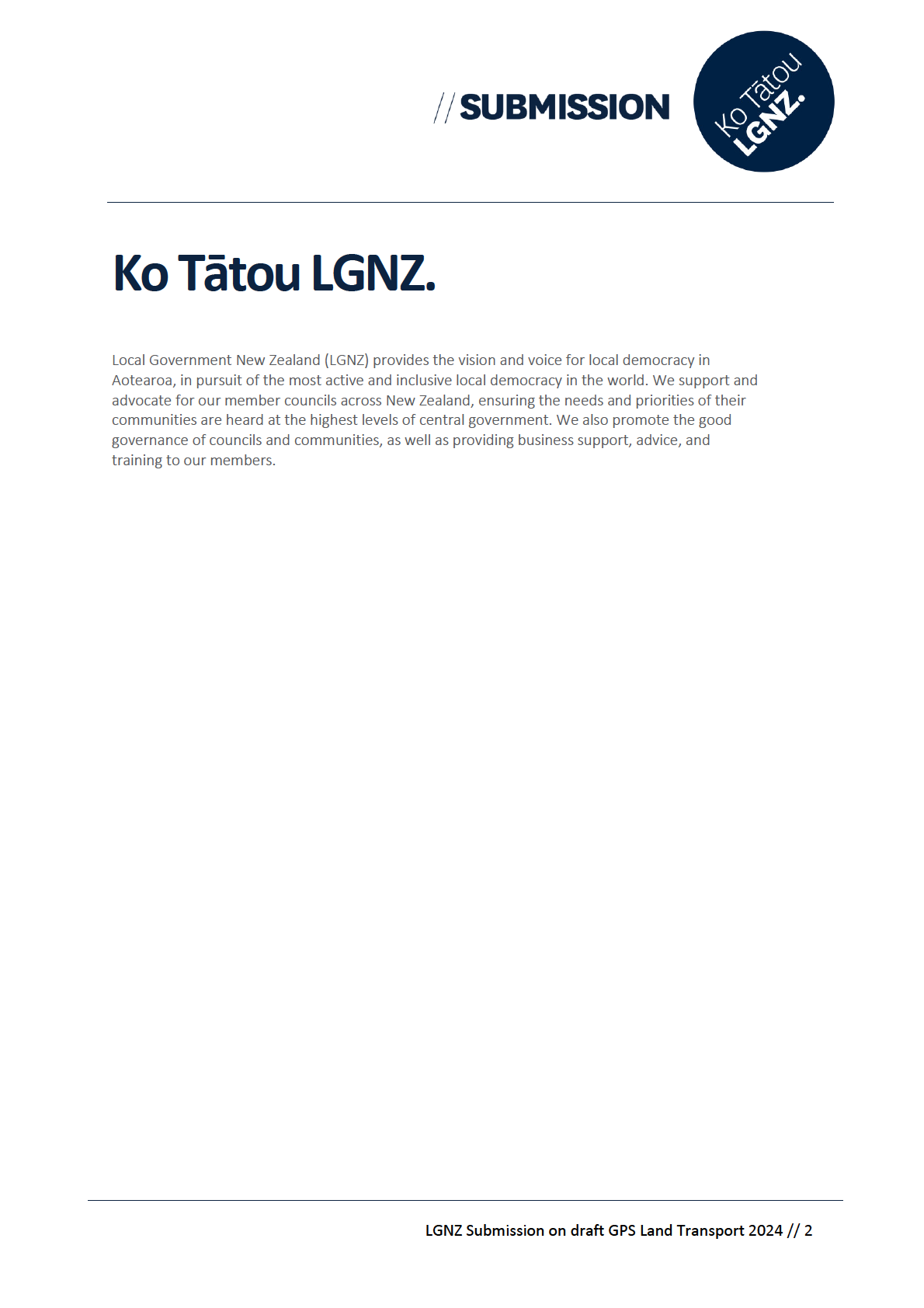
1982
THE
ACT
UNDER
INFORMATION
RELEASED
OFFICIAL
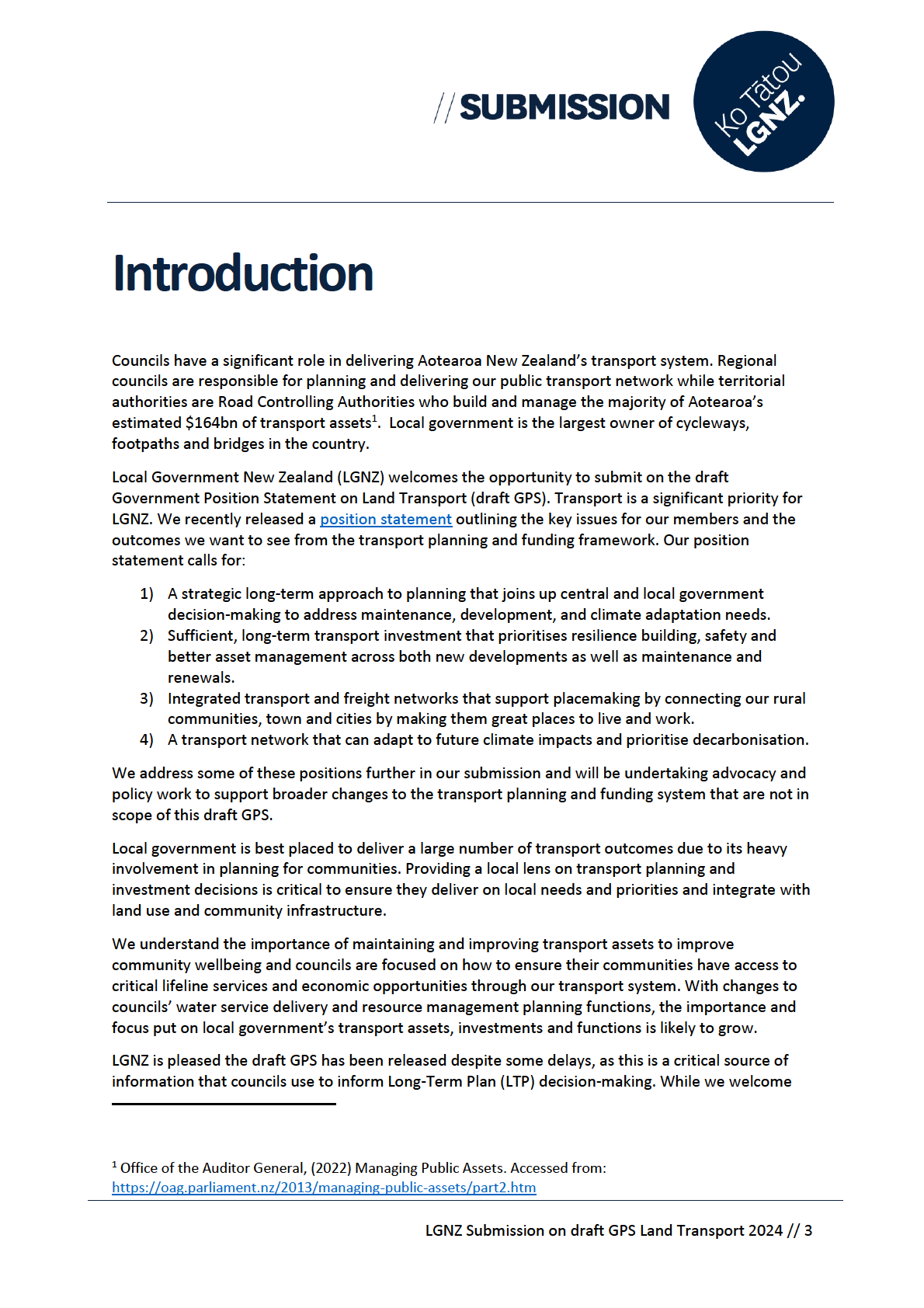
1982
THE
ACT
UNDER
INFORMATION
RELEASED
OFFICIAL
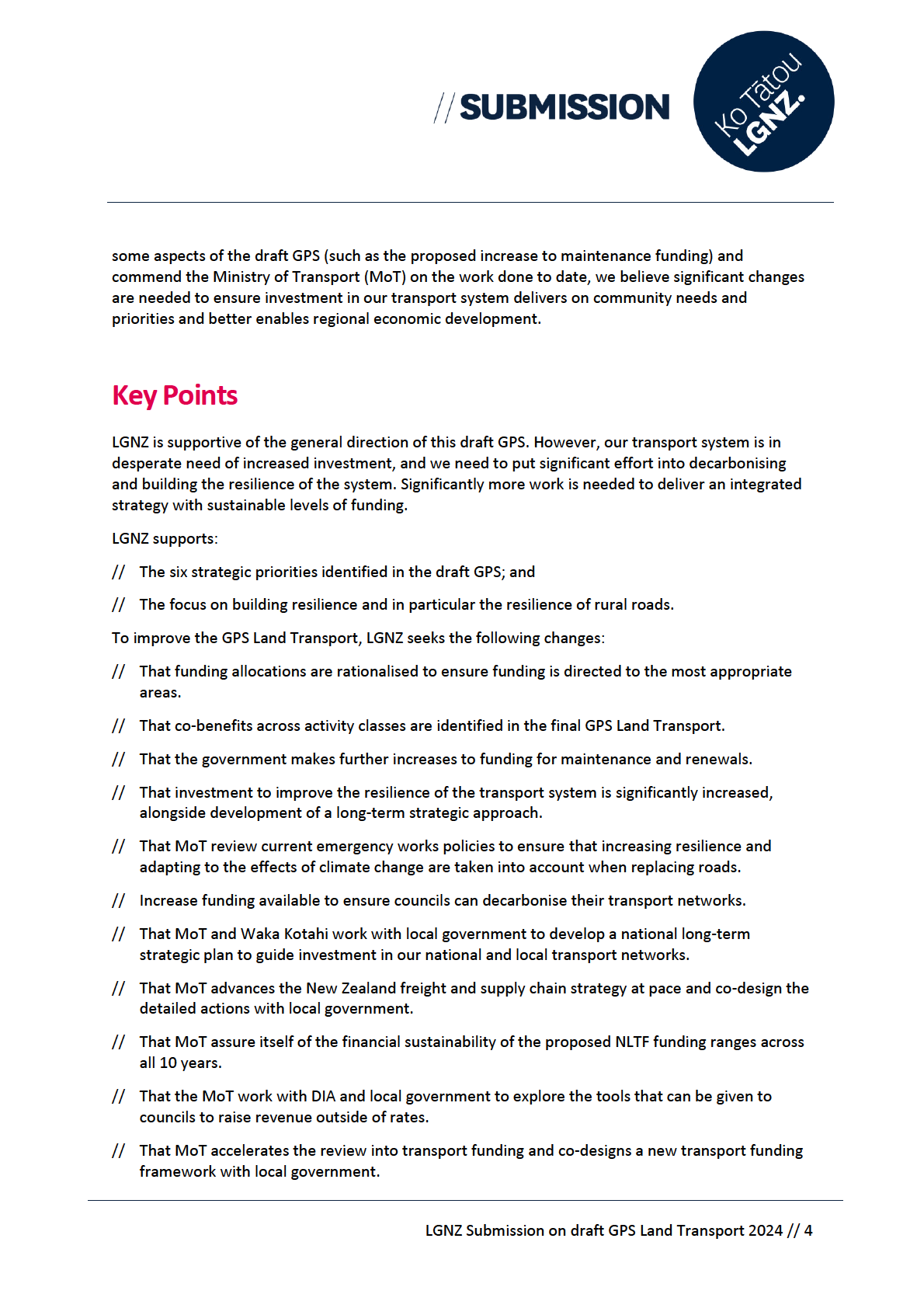
1982
THE
ACT
UNDER
INFORMATION
RELEASED
OFFICIAL

1982
THE
ACT
UNDER
INFORMATION
RELEASED
OFFICIAL

1982
THE
ACT
UNDER
INFORMATION
RELEASED
OFFICIAL

1982
THE
ACT
UNDER
INFORMATION
RELEASED
OFFICIAL

1982
THE
ACT
UNDER
INFORMATION
RELEASED
OFFICIAL
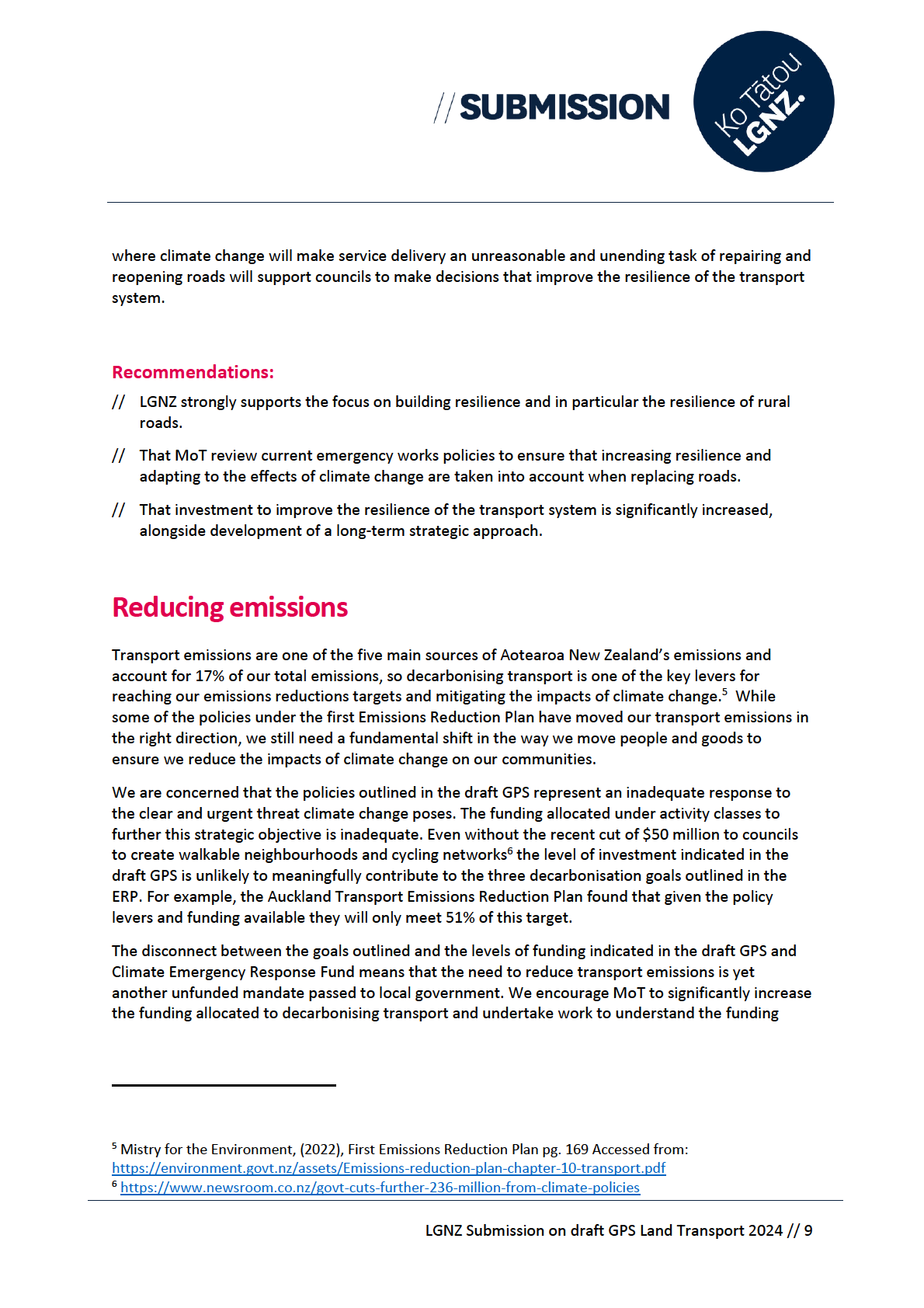
1982
THE
ACT
UNDER
INFORMATION
RELEASED
OFFICIAL

1982
THE
ACT
UNDER
INFORMATION
RELEASED
OFFICIAL
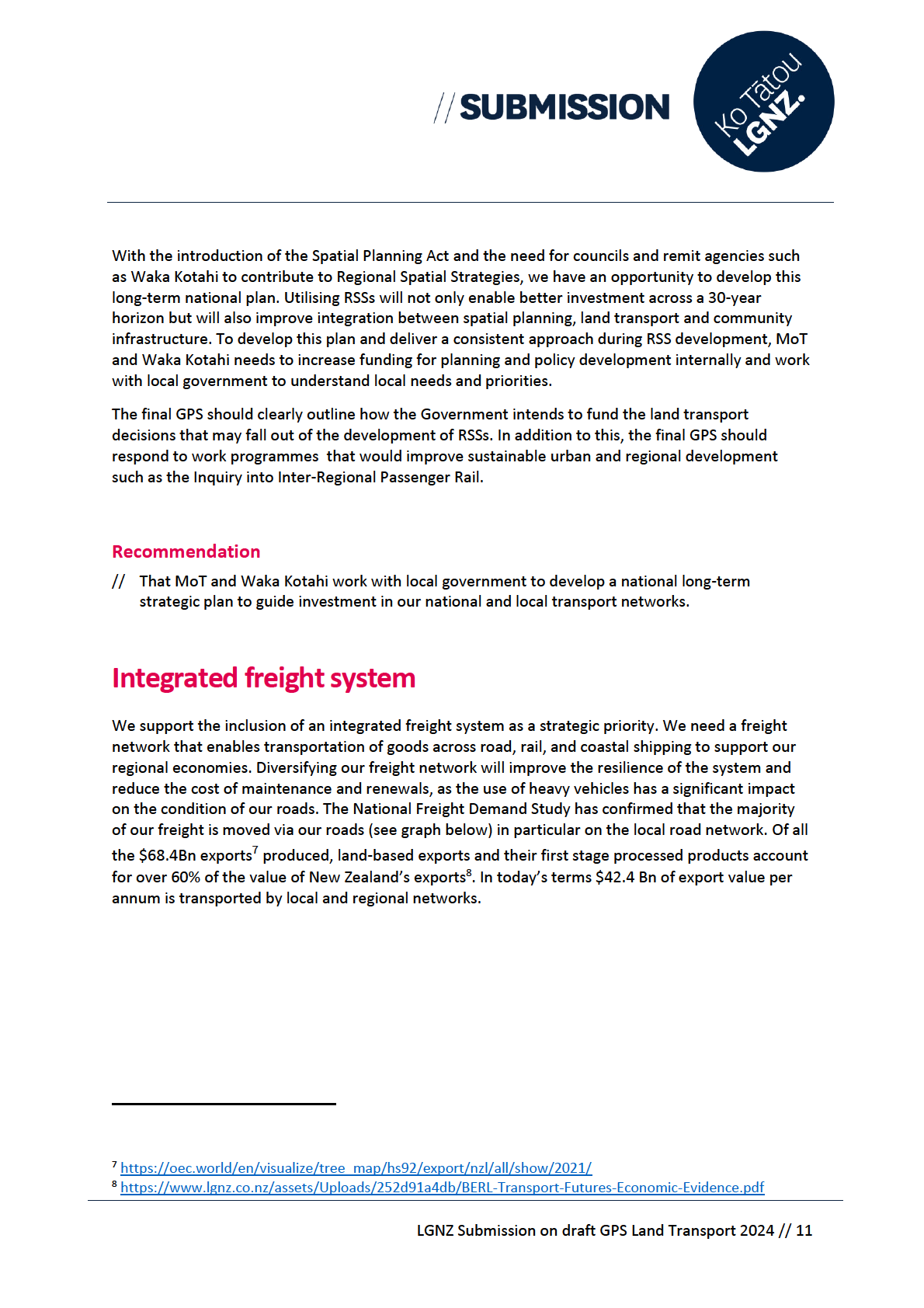
1982
THE
ACT
UNDER
INFORMATION
RELEASED
OFFICIAL
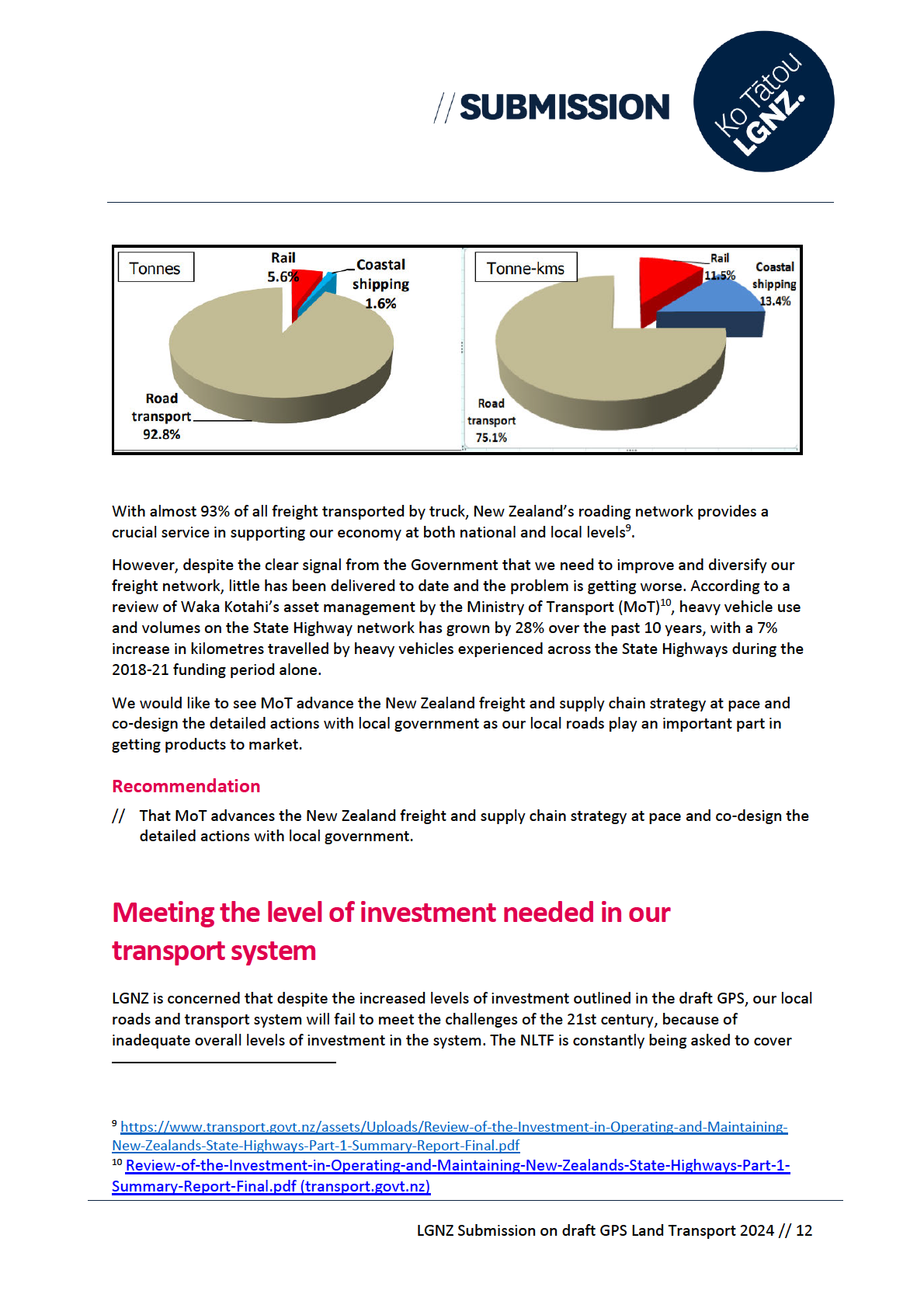
1982
THE
ACT
UNDER
INFORMATION
RELEASED
OFFICIAL
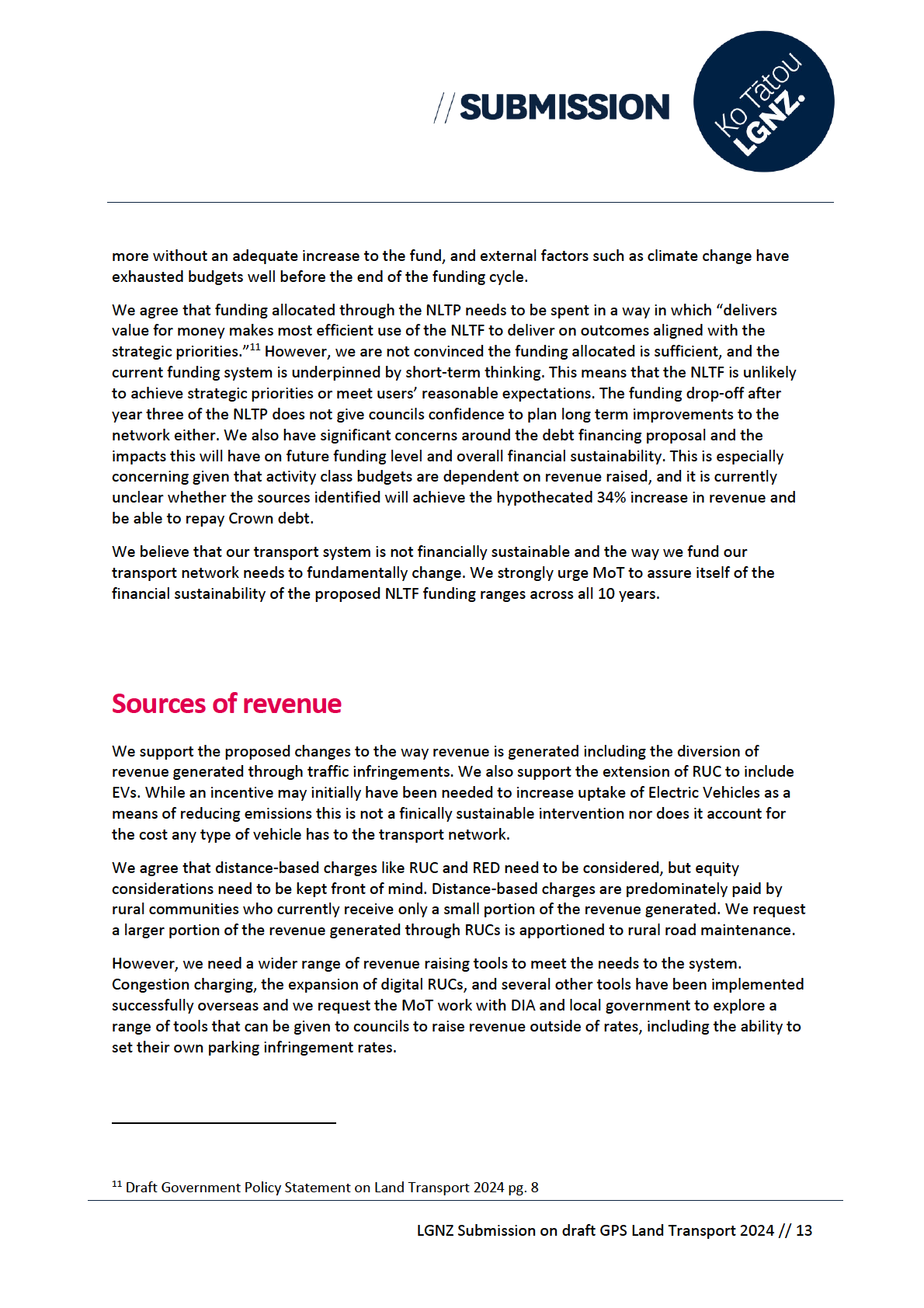
1982
THE
ACT
UNDER
INFORMATION
RELEASED
OFFICIAL
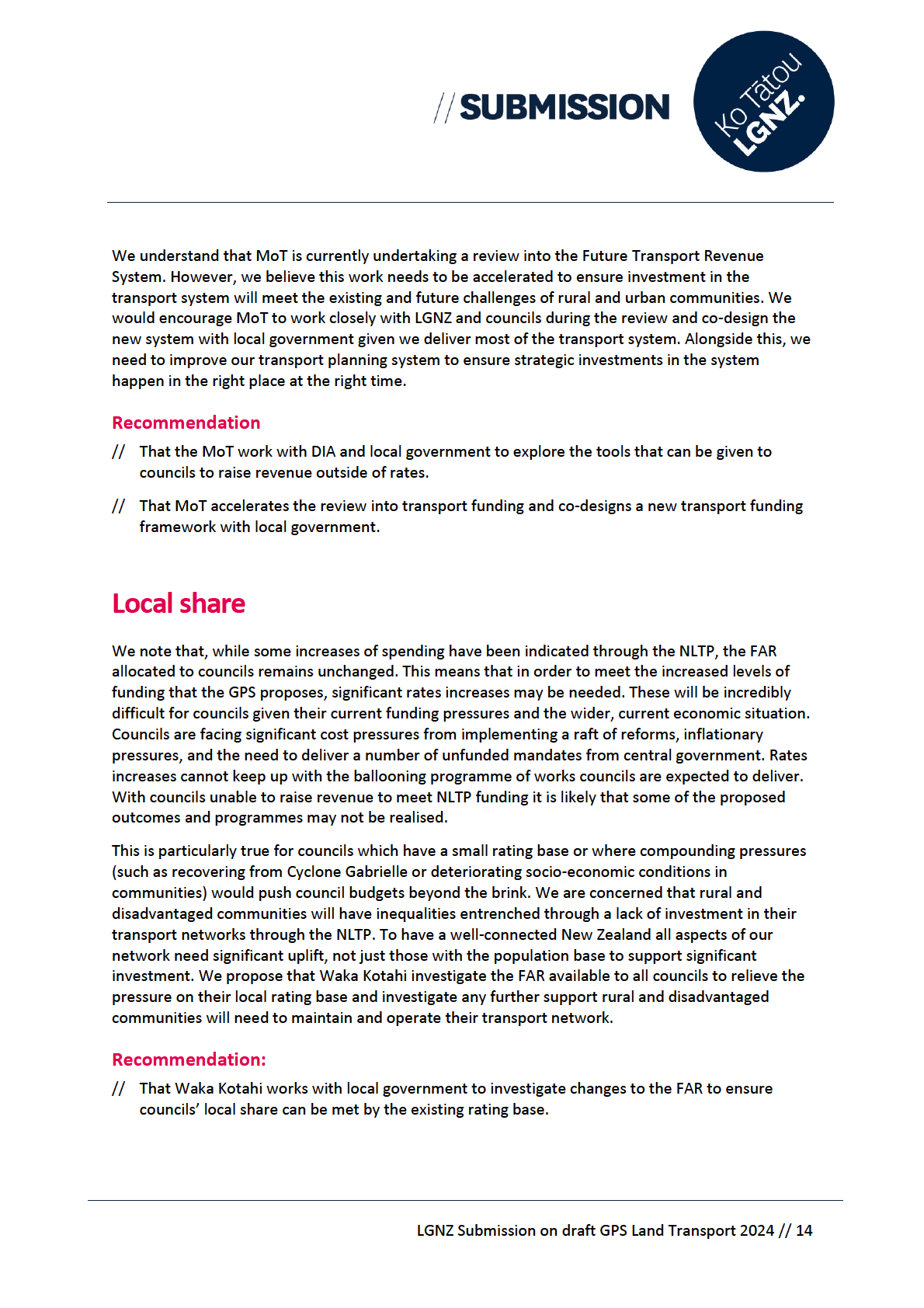
1982
THE
ACT
UNDER
INFORMATION
RELEASED
OFFICIAL
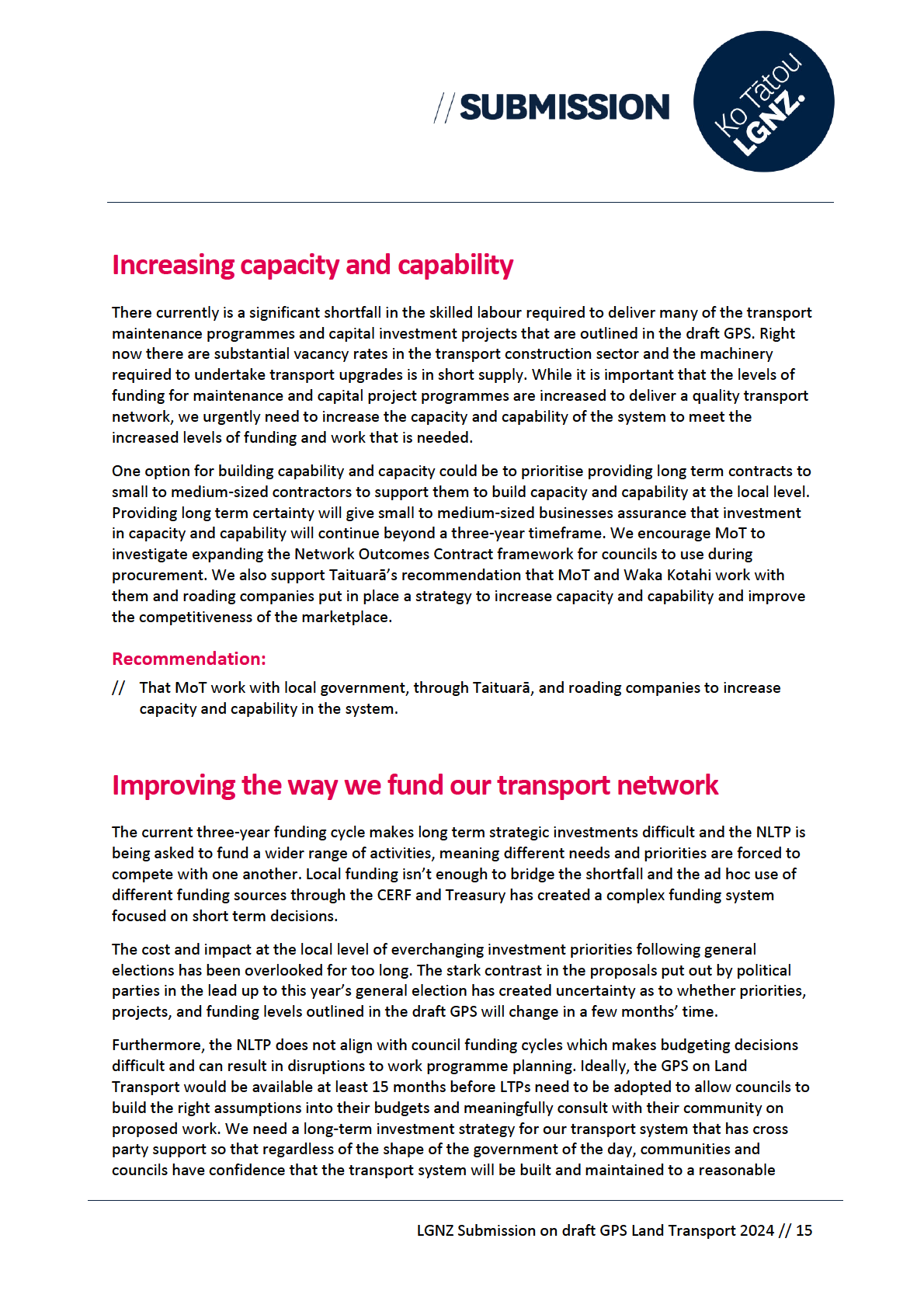
1982
THE
ACT
UNDER
INFORMATION
RELEASED
OFFICIAL
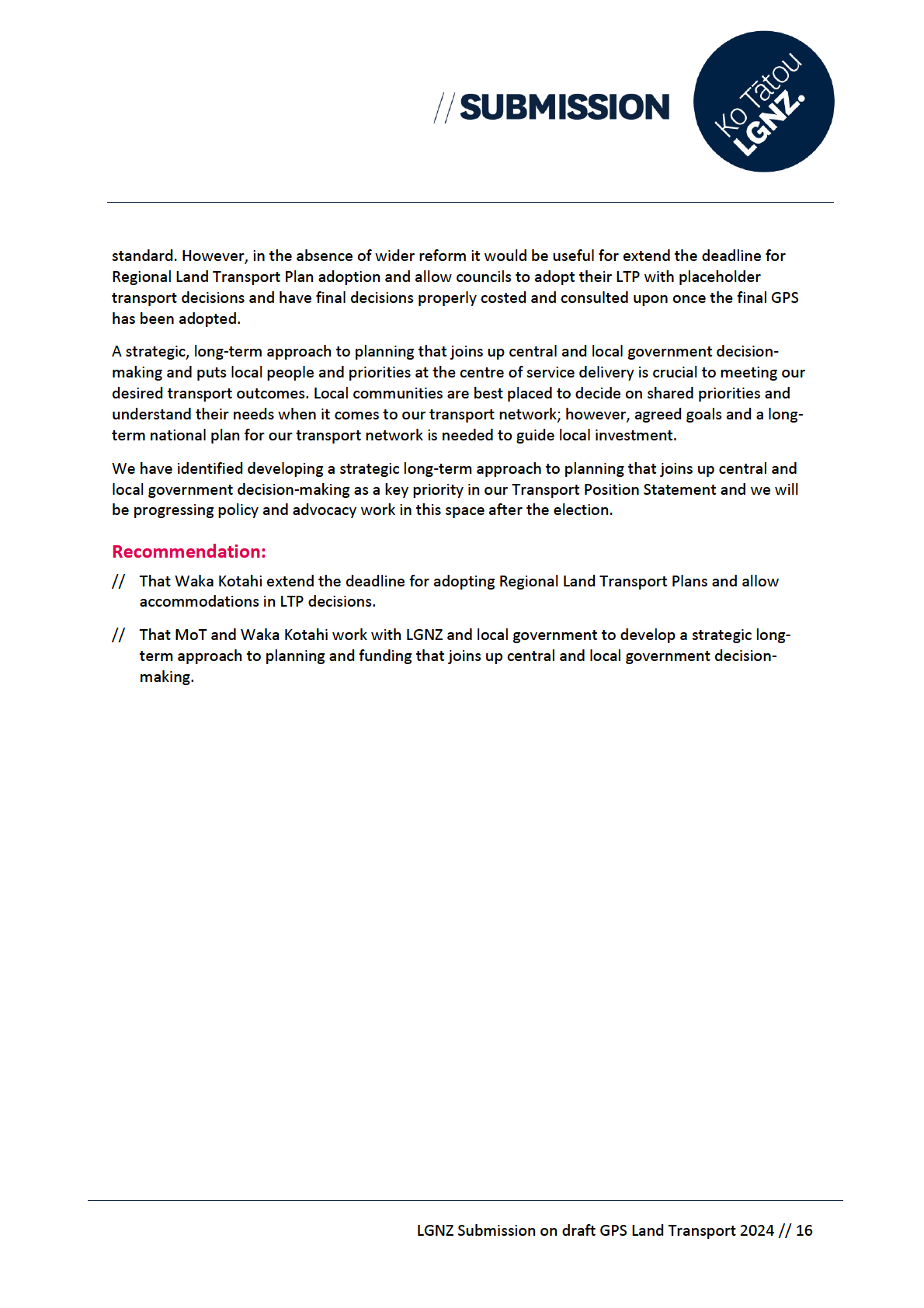
1982
THE
ACT
UNDER
INFORMATION
RELEASED
OFFICIAL
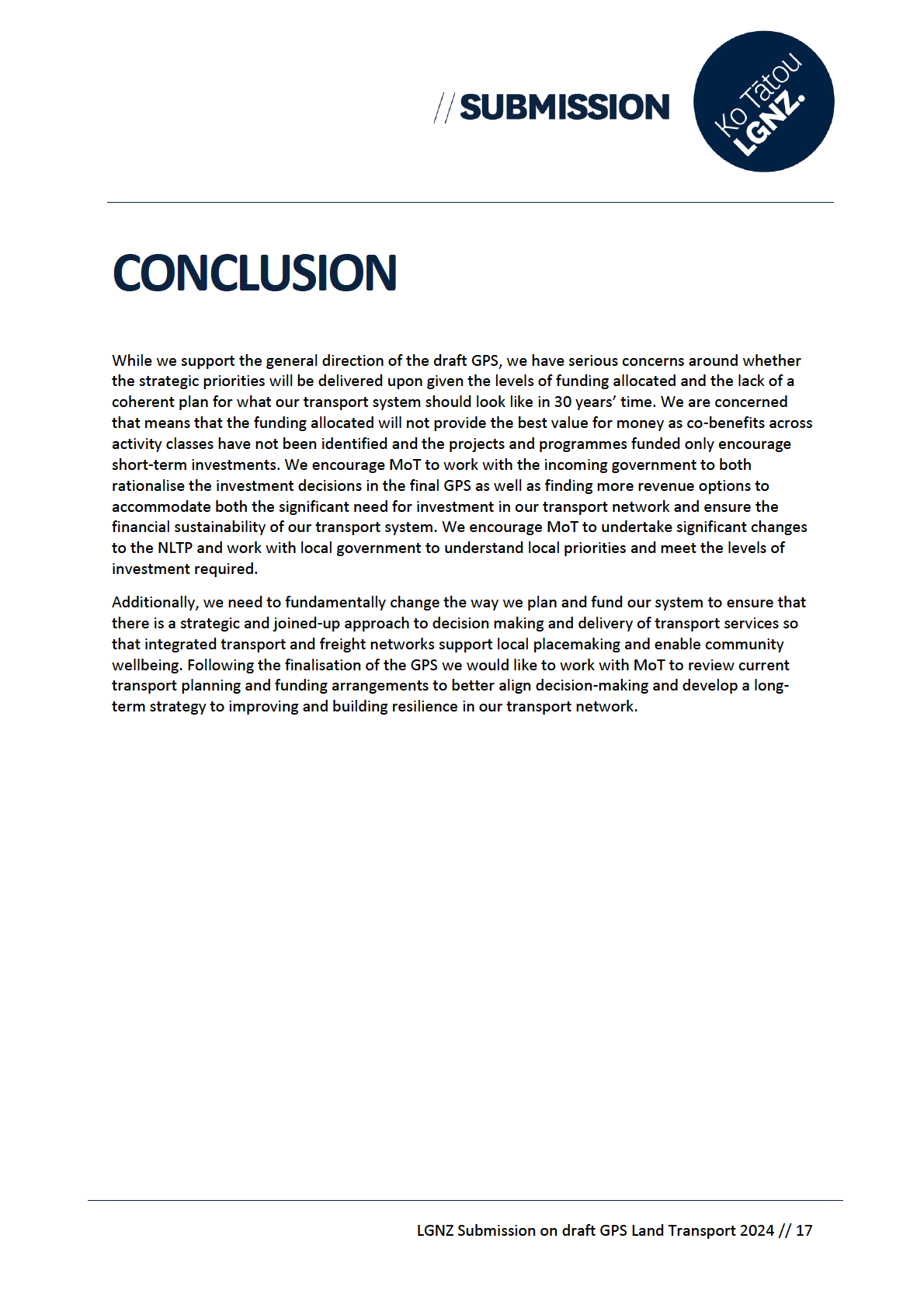
1982
THE
ACT
UNDER
INFORMATION
RELEASED
OFFICIAL


























